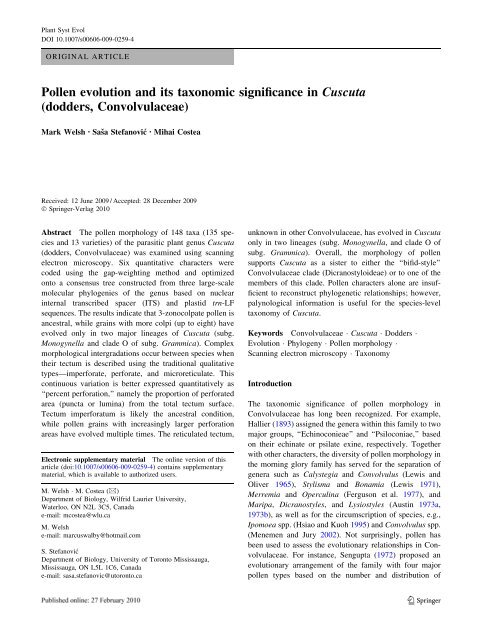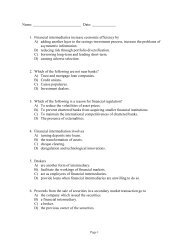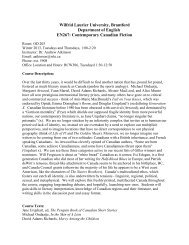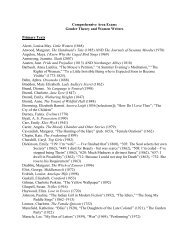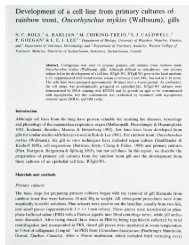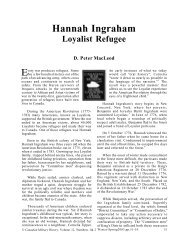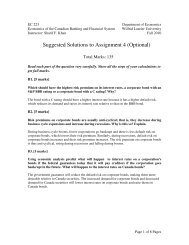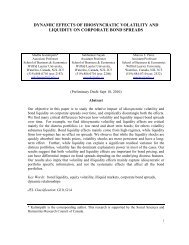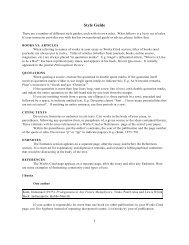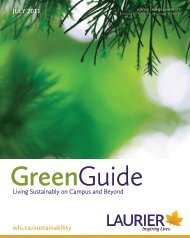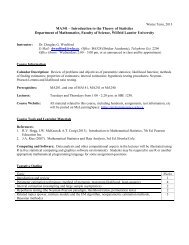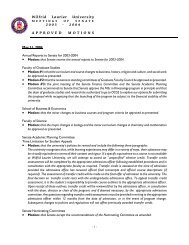Pollen evolution and its taxonomic significance in Cuscuta (dodders ...
Pollen evolution and its taxonomic significance in Cuscuta (dodders ...
Pollen evolution and its taxonomic significance in Cuscuta (dodders ...
Create successful ePaper yourself
Turn your PDF publications into a flip-book with our unique Google optimized e-Paper software.
Plant Syst Evol<br />
DOI 10.1007/s00606-009-0259-4<br />
ORIGINAL ARTICLE<br />
<strong>Pollen</strong> <strong>evolution</strong> <strong>and</strong> <strong>its</strong> <strong>taxonomic</strong> <strong>significance</strong> <strong>in</strong> <strong>Cuscuta</strong><br />
(<strong>dodders</strong>, Convolvulaceae)<br />
Mark Welsh • Saša Stefanović • Mihai Costea<br />
Received: 12 June 2009 / Accepted: 28 December 2009<br />
Ó Spr<strong>in</strong>ger-Verlag 2010<br />
Abstract The pollen morphology of 148 taxa (135 species<br />
<strong>and</strong> 13 varieties) of the parasitic plant genus <strong>Cuscuta</strong><br />
(<strong>dodders</strong>, Convolvulaceae) was exam<strong>in</strong>ed us<strong>in</strong>g scann<strong>in</strong>g<br />
electron microscopy. Six quantitative characters were<br />
coded us<strong>in</strong>g the gap-weight<strong>in</strong>g method <strong>and</strong> optimized<br />
onto a consensus tree constructed from three large-scale<br />
molecular phylogenies of the genus based on nuclear<br />
<strong>in</strong>ternal transcribed spacer (ITS) <strong>and</strong> plastid trn-LF<br />
sequences. The results <strong>in</strong>dicate that 3-zonocolpate pollen is<br />
ancestral, while gra<strong>in</strong>s with more colpi (up to eight) have<br />
evolved only <strong>in</strong> two major l<strong>in</strong>eages of <strong>Cuscuta</strong> (subg.<br />
Monogynella <strong>and</strong> clade O of subg. Grammica). Complex<br />
morphological <strong>in</strong>tergradations occur between species when<br />
their tectum is described us<strong>in</strong>g the traditional qualitative<br />
types—imperforate, perforate, <strong>and</strong> microreticulate. This<br />
cont<strong>in</strong>uous variation is better expressed quantitatively as<br />
‘‘percent perforation,’’ namely the proportion of perforated<br />
area (puncta or lum<strong>in</strong>a) from the total tectum surface.<br />
Tectum imperforatum is likely the ancestral condition,<br />
while pollen gra<strong>in</strong>s with <strong>in</strong>creas<strong>in</strong>gly larger perforation<br />
areas have evolved multiple times. The reticulated tectum,<br />
Electronic supplementary material The onl<strong>in</strong>e version of this<br />
article (doi:10.1007/s00606-009-0259-4) conta<strong>in</strong>s supplementary<br />
material, which is available to authorized users.<br />
M. Welsh M. Costea (&)<br />
Department of Biology, Wilfrid Laurier University,<br />
Waterloo, ON N2L 3C5, Canada<br />
e-mail: mcostea@wlu.ca<br />
M. Welsh<br />
e-mail: marcuswalby@hotmail.com<br />
S. Stefanović<br />
Department of Biology, University of Toronto Mississauga,<br />
Mississauga, ON L5L 1C6, Canada<br />
e-mail: sasa.stefanovic@utoronto.ca<br />
unknown <strong>in</strong> other Convolvulaceae, has evolved <strong>in</strong> <strong>Cuscuta</strong><br />
only <strong>in</strong> two l<strong>in</strong>eages (subg. Monogynella, <strong>and</strong> clade O of<br />
subg. Grammica). Overall, the morphology of pollen<br />
supports <strong>Cuscuta</strong> as a sister to either the ‘‘bifid-style’’<br />
Convolvulaceae clade (Dicranostyloideae) or to one of the<br />
members of this clade. <strong>Pollen</strong> characters alone are <strong>in</strong>sufficient<br />
to reconstruct phylogenetic relationships; however,<br />
palynological <strong>in</strong>formation is useful for the species-level<br />
taxonomy of <strong>Cuscuta</strong>.<br />
Keywords Convolvulaceae <strong>Cuscuta</strong> Dodders <br />
Evolution Phylogeny <strong>Pollen</strong> morphology <br />
Scann<strong>in</strong>g electron microscopy Taxonomy<br />
Introduction<br />
The <strong>taxonomic</strong> <strong>significance</strong> of pollen morphology <strong>in</strong><br />
Convolvulaceae has long been recognized. For example,<br />
Hallier (1893) assigned the genera with<strong>in</strong> this family to two<br />
major groups, ‘‘Ech<strong>in</strong>oconieae’’ <strong>and</strong> ‘‘Psiloconiae,’’ based<br />
on their ech<strong>in</strong>ate or psilate ex<strong>in</strong>e, respectively. Together<br />
with other characters, the diversity of pollen morphology <strong>in</strong><br />
the morn<strong>in</strong>g glory family has served for the separation of<br />
genera such as Calystegia <strong>and</strong> Convolvulus (Lewis <strong>and</strong><br />
Oliver 1965), Stylisma <strong>and</strong> Bonamia (Lewis 1971),<br />
Merremia <strong>and</strong> Opercul<strong>in</strong>a (Ferguson et al. 1977), <strong>and</strong><br />
Maripa, Dicranostyles, <strong>and</strong> Lysiostyles (Aust<strong>in</strong> 1973a,<br />
1973b), as well as for the circumscription of species, e.g.,<br />
Ipomoea spp. (Hsiao <strong>and</strong> Kuoh 1995) <strong>and</strong> Convolvulus spp.<br />
(Menemen <strong>and</strong> Jury 2002). Not surpris<strong>in</strong>gly, pollen has<br />
been used to assess the <strong>evolution</strong>ary relationships <strong>in</strong> Convolvulaceae.<br />
For <strong>in</strong>stance, Sengupta (1972) proposed an<br />
<strong>evolution</strong>ary arrangement of the family with four major<br />
pollen types based on the number <strong>and</strong> distribution of<br />
123
M. Welsh et al.<br />
apertures. Tellería <strong>and</strong> Daners (2003) found ex<strong>in</strong>e to be<br />
more relevant <strong>taxonomic</strong>ally than aperture features, <strong>and</strong><br />
based on the former characters, dist<strong>in</strong>guished three major<br />
groups of pollen: tectate, microech<strong>in</strong>ate-perforate; tectate,<br />
microech<strong>in</strong>ate-perforate with microsp<strong>in</strong>es; <strong>and</strong> semitectate,<br />
microech<strong>in</strong>ate-microreticulate.<br />
<strong>Cuscuta</strong> (<strong>dodders</strong>), a genus compris<strong>in</strong>g over 180 species<br />
of holoparasitic v<strong>in</strong>es (Stefanović et al. 2007), is nested<br />
with<strong>in</strong> Convolvulaceae (Stefanović <strong>and</strong> Olmstead 2004). It<br />
represents the third most economically important group of<br />
parasitic plants after Striga <strong>and</strong> Orobanche, because<br />
<strong>in</strong>festation by ca. 15 of <strong>its</strong> species can result <strong>in</strong> significant<br />
yield losses <strong>in</strong> numerous crops worldwide (Parker <strong>and</strong><br />
Riches 1993; Dawson et al. 1994; Costea <strong>and</strong> Tardif 2006).<br />
Additionally, numerous <strong>Cuscuta</strong> species are rare <strong>and</strong><br />
endangered, requir<strong>in</strong>g conservation measures (Costea <strong>and</strong><br />
Stefanović 2009a).<br />
As a result of their parasitic lifestyle, <strong>dodders</strong> exhibit<br />
extreme reductions of the vegetative structures, limit<strong>in</strong>g the<br />
morphological characters available for systematic studies<br />
to flowers <strong>and</strong> fruit (Stefanović et al. 2007). It is therefore<br />
imperative to search for <strong>and</strong> discover new characters useful<br />
for the taxonomy of the genus, as well as to create a theoretical<br />
basis for character <strong>evolution</strong> analysis.<br />
<strong>Pollen</strong> <strong>in</strong>formation for <strong>Cuscuta</strong> is relatively scarce. Das<br />
<strong>and</strong> Banerji (1966) described the ‘‘rugulate’’ pollen surface<br />
of C. santapaui <strong>and</strong> C. reflexa, while Ja<strong>in</strong> <strong>and</strong> N<strong>and</strong>a<br />
(1966) compared the pollen morphology of <strong>Cuscuta</strong> hyal<strong>in</strong>a<br />
<strong>and</strong> Convolvulus pluricaulis Choisy. Sengupta (1972)<br />
studied 21 species of <strong>Cuscuta</strong>, which he divided <strong>in</strong>to two<br />
groups accord<strong>in</strong>g to their tricolpate or penta-hexa-colpate<br />
pollen. Liao et al. (2005) analyzed four species from Taiwan,<br />
also recogniz<strong>in</strong>g two ma<strong>in</strong> types of pollen based on<br />
ex<strong>in</strong>e morphology. Type 1, observed <strong>in</strong> C. australis,<br />
C. campestris, <strong>and</strong> C. ch<strong>in</strong>ensis, is characterized by an<br />
ektex<strong>in</strong>e ‘‘f<strong>in</strong>ely reticulate,’’ whereas type 2 exhibited a<br />
reticulate ektex<strong>in</strong>e, as seen <strong>in</strong> C. japonica (Liao et al.<br />
2005). Despite the limited sampl<strong>in</strong>g, these studies concluded<br />
that pollen provides important phylogenetic <strong>and</strong><br />
<strong>taxonomic</strong> <strong>in</strong>formation. Recently, Costea et al. (2006a,<br />
2006b, 2006c, 2006d, 2008a, 2008b) described the pollen<br />
of 24 species as a part of <strong>taxonomic</strong> revisions of major<br />
clades that belong to subg. Grammica. Therefore, to date,<br />
pollen morphology of only about one-quarter of <strong>Cuscuta</strong><br />
species is known. More importantly, pollen diversity <strong>in</strong> this<br />
genus has never been analyzed <strong>in</strong> a broad-scale <strong>evolution</strong>ary<br />
context, <strong>in</strong> a firmly established phylogenetic<br />
framework.<br />
The precise sister group relationships of <strong>Cuscuta</strong> with<br />
other Convolvulaceae members are not clear (Stefanović<br />
et al. 2002, 2003; Stefanović <strong>and</strong> Olmstead 2004). However,<br />
well-supported phylogenies based on both plastid <strong>and</strong><br />
nuclear datasets are available for the genus <strong>its</strong>elf (García<br />
<strong>and</strong> Mart<strong>in</strong> 2007; Stefanović et al. 2007). This newly<br />
established phylogenetic framework enables the exam<strong>in</strong>ation<br />
of pollen characters from an <strong>evolution</strong>ary perspective.<br />
Thus, the ma<strong>in</strong> goals of this study are to: (1) survey the<br />
diversity of pollen morphology across the genus, (2) place<br />
this morphological variation <strong>in</strong>to an <strong>evolution</strong>ary context,<br />
<strong>and</strong> (3) assess the usefulness of pollen ex<strong>in</strong>e morphology<br />
for the systematics of <strong>Cuscuta</strong>.<br />
Materials <strong>and</strong> methods<br />
Sampl<strong>in</strong>g <strong>and</strong> scann<strong>in</strong>g electron microscopy<br />
A total of 148 taxa (135 species <strong>and</strong> 13 varieties) were<br />
exam<strong>in</strong>ed us<strong>in</strong>g 372 herbarium specimens (Appendix).<br />
Efforts were made to sample multiple accessions, particularly<br />
for those species spann<strong>in</strong>g large biogeographical<br />
ranges <strong>and</strong>/or hav<strong>in</strong>g a diverse morphology. As a result,<br />
with the exception of the species known from only one<br />
specimen, all of the exam<strong>in</strong>ed taxa are represented by two<br />
or more collections. Mature anthers were fragmented on<br />
the stubs without acetolysis to preserve the ex<strong>in</strong>e <strong>and</strong> <strong>in</strong>t<strong>in</strong>e<br />
(Harley <strong>and</strong> Ferguson 1990). Samples were coated with<br />
20 nm of gold us<strong>in</strong>g an Emitech K 550 sputter-coater, <strong>and</strong><br />
exam<strong>in</strong>ed with a Hitachi S-570, Hitachi SU-1500 or LEO<br />
1530 FE-SEM at 10-15 kV. Photographs illustrat<strong>in</strong>g the<br />
details of pollen for all the taxa are provided on the Digital<br />
Atlas of <strong>Cuscuta</strong> website (Costea 2007 onwards). <strong>Pollen</strong><br />
measurements were performed on digital SEM images<br />
us<strong>in</strong>g Carnoy 2.0 for Mac OS X (Schols et al. 2002), <strong>and</strong><br />
ImageJ (Abramoff et al. 2004) was used for determ<strong>in</strong>ation<br />
of areas.<br />
<strong>Pollen</strong> characters<br />
We used the term<strong>in</strong>ology of Punt et al. (2007) to prelim<strong>in</strong>arily<br />
evaluate the morphological variation of tectum<br />
perforations <strong>in</strong>to discrete types, potentially utilizable as<br />
qualitative state characters. The correspond<strong>in</strong>g tectum<br />
types encountered <strong>in</strong> <strong>Cuscuta</strong> are: imperforate (no perforations<br />
present), perforate (tectum with puncta \1 lm),<br />
microreticulate (reticulate ornamentation consist<strong>in</strong>g of<br />
muri <strong>and</strong> lum<strong>in</strong>a \1 lm), <strong>and</strong> reticulate (similar to the<br />
previous, but lum<strong>in</strong>a [1 lm) (Punt et al. 2007). However,<br />
the tectum variation <strong>in</strong> <strong>Cuscuta</strong> could not be consistently<br />
separated <strong>in</strong>to these types, because complex morphological<br />
<strong>in</strong>tergradations occur, especially among the imperforate,<br />
perforate, <strong>and</strong> microreticulate pollen gra<strong>in</strong>s of different<br />
species. Therefore, we def<strong>in</strong>ed tectum variation quantitatively<br />
as ‘‘percent perforation,’’ namely the proportion of<br />
the perforation surface (puncta or lum<strong>in</strong>a) from the total<br />
surface of the tectum. Comparable quantitative measures,<br />
123
<strong>Pollen</strong> <strong>evolution</strong> <strong>and</strong> <strong>its</strong> <strong>taxonomic</strong> <strong>significance</strong> <strong>in</strong> <strong>Cuscuta</strong><br />
e.g., the ‘‘perforation density’’ (Vezey et al. 1991) <strong>and</strong><br />
‘‘percent tectum coverage’’ (Vezey et al. 1992), have previously<br />
been used <strong>in</strong> other groups of plants, yet they have<br />
not achieved widespread acceptance despite the fact that<br />
they provide a more accurate description of tectum<br />
morphology.<br />
Five other quantitative characters—pollen length (polar<br />
axis), polar/equatorial (P/E) ratio, average diameter of<br />
perforations (puncta or lum<strong>in</strong>a), average surface of perforations,<br />
<strong>and</strong> number of colpi—were also exam<strong>in</strong>ed. The<br />
number of colpi exhibited a discrete variation: 3(–4) or (4–)<br />
5–8 colpi. The rema<strong>in</strong><strong>in</strong>g characters varied cont<strong>in</strong>uously<br />
<strong>and</strong> were coded us<strong>in</strong>g Thiele’s (1993) gap-weight<strong>in</strong>g<br />
method as implemented by MorphoCode (Schols et al.<br />
2004). Gap-weight<strong>in</strong>g was preferred to various gap-cod<strong>in</strong>g<br />
methods (reviewed by Wiens 2001; Swiderski et al. 1998)<br />
because of the better phylogenetic signal recovered (see<br />
also García-Cruz <strong>and</strong> Sosa 2006). The maximum number<br />
of resulted character states (n) was ten for all the quantitative<br />
characters, except for the percent perforation where n<br />
was eight. Eight character states were sufficient to describe<br />
tectum perforation patterns (Table 1).<br />
Us<strong>in</strong>g formal outgroup analysis (e.g., Maddison et al.<br />
1984) to determ<strong>in</strong>e character polarity <strong>in</strong> <strong>Cuscuta</strong> is h<strong>in</strong>dered<br />
by two factors. First, despite considerable efforts,<br />
outgroup relationships of <strong>Cuscuta</strong> are unknown (Stefanović<br />
<strong>and</strong> Olmstead 2004). The position of <strong>Cuscuta</strong> <strong>in</strong> Convolvulaceae<br />
was, however, narrowed down to three possible<br />
phylogenetic scenarios (Stefanović et al. 2002; Stefanović<br />
<strong>and</strong> Olmstead 2004): (a) <strong>Cuscuta</strong> as a sister to the ‘‘bifidstyle’’<br />
clade (Dicranostyloideae) which comprises the<br />
tribes Hildebr<strong>and</strong>tieae, Cresseae, Dichondreae, <strong>and</strong> <strong>in</strong> part<br />
Convolvuleae, Poraneae, <strong>and</strong> Erycibeae; (b) <strong>Cuscuta</strong> as a<br />
sister to the ‘‘bifid clade’’ together with ‘‘clade 1’’ (Convolvuloideae)<br />
which <strong>in</strong>cludes the tribes Ipomoeae, Argyreieae,<br />
Merremiae, <strong>and</strong> some Convolvuleae. Together or<br />
<strong>in</strong>dividually, these major Convolvulaceae clades account<br />
for most of the diversity encountered <strong>in</strong> the family (e.g.,<br />
‘‘clade 1’’ alone has over two-thirds of the species <strong>in</strong><br />
Convolvulaceae); (c) <strong>Cuscuta</strong> as a sister to one of the<br />
members of the ‘‘bifid clade,’’ although this possibility<br />
was deemed ‘‘unlikely’’ <strong>and</strong> could not be formally tested<br />
because the relationships with<strong>in</strong> this clade were unresolved<br />
(Stefanović et al. 2002; Stefanović <strong>and</strong> Olmstead 2004).<br />
Second, not all the Convolvulaceae genera/species from<br />
these groups have been studied <strong>in</strong> regards to their pollen<br />
morphology. For these reasons, our <strong>in</strong>terpretation of character<br />
polarity <strong>in</strong> <strong>Cuscuta</strong> also takes <strong>in</strong>to account the<br />
<strong>in</strong>group distribution of character states at the level of both<br />
<strong>Cuscuta</strong> <strong>and</strong> Convolvulaceae (reviewed by Stuessy 2008).<br />
Characters were mapped onto a summary consensus tree<br />
built <strong>in</strong> MacClade 4 (Maddison <strong>and</strong> Maddison 2000),<br />
result<strong>in</strong>g from the comb<strong>in</strong>ation of two large-scale molecular<br />
phylogenies of <strong>Cuscuta</strong> based on plastid trn-LF <strong>and</strong><br />
nuclear ITS sequences (subg. <strong>Cuscuta</strong>, García <strong>and</strong> Mart<strong>in</strong><br />
2007; subg. Grammica Stefanović et al. 2007), <strong>and</strong> an<br />
unpublished phylogeny of the entire genus (Stefanović<br />
<strong>and</strong> Costea, personal communication). ACCTRAN <strong>and</strong><br />
DELTRAN were turned off <strong>and</strong> <strong>in</strong>stances of bootstrap<br />
values below 85% were considered unresolved <strong>and</strong> are<br />
<strong>in</strong>dicated <strong>in</strong> the tree as polytomies.<br />
Results <strong>and</strong> discussion<br />
Number of apertures<br />
<strong>Pollen</strong> of <strong>Cuscuta</strong> is heteromorphic (sensu Till-Bottraud<br />
et al. 1995) (Fig. 1a–d). Over 95% of the species exam<strong>in</strong>ed<br />
can be characterized as 3-zonocolpate, but this prevalent<br />
apertural type may be accompanied <strong>in</strong> the same anther by a<br />
small proportion of 4-, 5- or even 6-zonocolpate gra<strong>in</strong>s, <strong>and</strong><br />
extremely rarely by pantocolpate gra<strong>in</strong>s. A similar variation<br />
of ±2 apertures can be observed <strong>in</strong> the species with<br />
preponderantly 5- <strong>and</strong> 7-zonocolpate pollen gra<strong>in</strong>s, which<br />
<strong>in</strong> addition may also produce pantocolpate morphs.<br />
Apertural heteromorphism is common <strong>in</strong> numerous angiosperms<br />
(Erdtman 1966; Van Campo 1976; Mignot et al.<br />
Table 1 Percent perforation<br />
quantitative character states <strong>and</strong><br />
their correspond<strong>in</strong>g tectum<br />
‘‘types’’ resulted from cod<strong>in</strong>g<br />
us<strong>in</strong>g Thiele’s (1993) gapweight<strong>in</strong>g<br />
method<br />
Percent perforation character states determ<strong>in</strong>ed<br />
with MorphoCode (Schols et al. 2004) (%)<br />
Diameter of puncta/<br />
lum<strong>in</strong>a (lm)<br />
Correspond<strong>in</strong>g<br />
tectum ‘‘types’’<br />
0–2.1 0.2 (0–0.6) Tectum imperforatum (TI)<br />
2.6–6.3 0.43 (0.14–1.2) Tectum perforatum 1 (TP1)<br />
8.3–12.1 0.62 (0.14–1.5) Tectum perforatum 2 (TP2)<br />
12.5–17.3 0.67 (0.17–1.62) Microreticulate 1 (MR1)<br />
17.7–21.9 0.7 (0.2–1.77) Microreticulate 2 (MR2)<br />
30.8–31.3 1.9 (0.85–2.91) Reticulate 1 (R1)<br />
34.3 2.65 (1.52–3.85) Reticulate 2 (R2)<br />
43.6–44.6 3.03 (0.8–5.82) Reticulate 3 (R3)<br />
123
M. Welsh et al.<br />
Fig. 1 Variation of colpi number (a–d). a <strong>Cuscuta</strong> purpusii,<br />
b C. argent<strong>in</strong>iana, c C. parodiana, d C. boliviana. Tectum variation<br />
(e–l, respectively); see Table 1 for abbreviations of tectum types.<br />
e <strong>Cuscuta</strong> brachycalyx (TI), f C. odontolepis (TP1), g C. polyanthemos<br />
(TP2), h C. cozumeliensis (MR1), i C. chapalana (MR2),<br />
j C. cassytoides (R1), k C. japonica (R2), l C. reflexa (R3). Tectum,<br />
surface detail (Table 1) (m–p) m C. decipiens (TI), n C. exaltata<br />
(TP2), o C. mitriformis (MR2), p C. santapaui (R3). Scale bars<br />
(A–L) 5 lm, (M–P) 0.5 lm<br />
123
<strong>Pollen</strong> <strong>evolution</strong> <strong>and</strong> <strong>its</strong> <strong>taxonomic</strong> <strong>significance</strong> <strong>in</strong> <strong>Cuscuta</strong><br />
1994) <strong>and</strong> can be l<strong>in</strong>ked ontogenetically to the succession<br />
of events that take place dur<strong>in</strong>g meiotic cytok<strong>in</strong>esis<br />
(Blackmore <strong>and</strong> Crane 1998; Ressayre et al. 2002, 2005).<br />
Experimental results from heteromorphic eudicots have<br />
shown that 4-apertured gra<strong>in</strong>s germ<strong>in</strong>ate faster than<br />
3-aperturate ones, but the latter have faster pollenic tube<br />
growth <strong>and</strong> better survival than the former (Dajoz et al.<br />
1991; Till-Bottraud et al. 1999). Together, these different<br />
morphotypes <strong>and</strong> their correspond<strong>in</strong>g pollen strategies<br />
maximize the chances of successful fertilization under<br />
different conditions.<br />
Although the number of apertures is not perfectly fixed<br />
with<strong>in</strong> the species of <strong>Cuscuta</strong>, this character is phylogenetically<br />
<strong>in</strong>formative. Sengupta (1972) suggested that the<br />
5–6-colpate gra<strong>in</strong>s of <strong>Cuscuta</strong> reflexa are derived compared<br />
with the 3-colpate pollen encountered <strong>in</strong> other dodder<br />
species. Our results support this hypothesis, because<br />
pollen gra<strong>in</strong>s with a higher number of apertures (5–8) have<br />
evolved <strong>in</strong> <strong>Cuscuta</strong> from the ancestral state with three colpi<br />
only <strong>in</strong> two l<strong>in</strong>eages (Fig. 2), <strong>in</strong> subg. Monogynella<br />
(C. reflexa <strong>and</strong> C. japonica) <strong>and</strong> <strong>in</strong> several species of a<br />
South American clade that belongs to subg. Grammica<br />
(clade O, see Stefanović et al. 2007). Sengupta (1972)<br />
proposed that an <strong>in</strong>creased number of apertures <strong>in</strong> <strong>Cuscuta</strong><br />
is associated with polyploidy. While C. reflexa is polyploid<br />
with several cytotypes (2n = 28, 30, 32, 42, 48; Kaul <strong>and</strong><br />
Bhan 1977), the very scarce cytological <strong>in</strong>formation<br />
available for the rema<strong>in</strong><strong>in</strong>g species does not seem to support<br />
this hypothesis. The entire genus is a polyploid complex,<br />
<strong>and</strong> some of the species with the highest numbers<br />
of chromosomes such as C. campestris (2n = ca. 56),<br />
C. cephalanthi, <strong>and</strong> C. gronovii (2n = 60) (Pazy <strong>and</strong><br />
Plitmann 1995) are tricolpate.<br />
The number of apertures has received considerable<br />
attention <strong>in</strong> Convolvulaceae. Similarly to other eudicots,<br />
tricolpate pollen has been regarded as plesiomorphic, while<br />
5-6-zonocolpate, pantocolpate, <strong>and</strong> pantoporate gra<strong>in</strong>s are<br />
considered progressively derived <strong>in</strong> the family (Wodehouse<br />
1936; Vishnu-Mittre 1964; Manitz 1970; Muller 1970;<br />
Sengupta 1972; Aust<strong>in</strong> 1973a, 1973b, 1998; Tellería <strong>and</strong><br />
Daners 2003). This <strong>evolution</strong>ary sequence, termed ‘‘successiformy’’<br />
by Van Campo (1976), can be encountered <strong>in</strong><br />
genera from both Convolvuloideae <strong>and</strong> Dicranostyloideae.<br />
For example, <strong>in</strong> the former clade, zonocolpate pollen gra<strong>in</strong>s<br />
with five or more apertures are found <strong>in</strong> Odonellia, a genus<br />
with two species (Robertson 1982), <strong>and</strong> several Meremia<br />
spp. [e.g., M. umbellata (L.) Hallier, Sengupta 1972;<br />
Tellería <strong>and</strong> Daners 2003; Leite et al. 2005; M. vitifolia<br />
(Burm. f.) Hallier f., <strong>and</strong> M. sibirica (L.) Hallier f.,<br />
Ferguson et al. 1977]. In Dicranostyloideae, Maripa <strong>and</strong><br />
Jacquemontia species exhibit complex heteromorphic<br />
variation patterns from tricolpate to pantocolpate (Robertson<br />
1971; Aust<strong>in</strong> 1973b).<br />
Ex<strong>in</strong>e<br />
Ex<strong>in</strong>e <strong>in</strong> <strong>Cuscuta</strong> is tectate imperforate or semitectate,<br />
perforate to reticulate (Fig. 1e–l), with a s<strong>in</strong>gle layer of<br />
unbranched columellae. Supratectal ornamentation typically<br />
consists of rounded to acute scabrate processes less<br />
than 1 lm long, more or less evenly distributed on the<br />
pollen surface (Fig. 1m–p). Larger supratectal conical<br />
sp<strong>in</strong>es ([1 lm) are present only <strong>in</strong> subg. Monogynella <strong>in</strong><br />
C. lehmanniana <strong>and</strong> C. monogyna. <strong>Pollen</strong> with reticulate<br />
tectum is unknown <strong>in</strong> other Convolvulaceae (see below)<br />
<strong>and</strong> has evolved <strong>in</strong> <strong>Cuscuta</strong> only <strong>in</strong> some species of subg.<br />
Monogynella <strong>and</strong> clade O of subg. Grammica (Fig. 3;<br />
Table 2). Sengupta (1972) characterized the pantoporate<br />
pollen gra<strong>in</strong>s of Ipomea as ‘‘complex-reticulate,’’ namely<br />
reticulate with a superimposed hexagonal pattern (the<br />
metareticulate pollen of Borsch <strong>and</strong> Barthlott 1998; Tellería<br />
<strong>and</strong> Daners 2003) <strong>and</strong> suggested that this type might<br />
have orig<strong>in</strong>ated from the hexacolpate, ‘‘simple reticulate’’<br />
of C. reflexa. However, as reported by Tellería <strong>and</strong> Daners<br />
(2003), the metareticulate pollen of many Ipomoea spp. <strong>in</strong><br />
fact has a microreticulate tectum, with a different ex<strong>in</strong>e<br />
structure <strong>and</strong> ornamentation.<br />
<strong>Pollen</strong> gra<strong>in</strong>s with smaller perforations (usually B1 lm)<br />
form a cont<strong>in</strong>uous transition from imperforate to microreticulate<br />
(Fig. 1e–l) with the former condition prevalent <strong>in</strong><br />
<strong>Cuscuta</strong> (ca. 60% of species) <strong>and</strong> encountered <strong>in</strong> many<br />
Convolvulaceae (Sengupta 1972; Aust<strong>in</strong> 1973a, 1973b;<br />
Tellería <strong>and</strong> Daners 2003). Because of the <strong>in</strong>tergradations<br />
observed, the types of pollen previously recognized on the<br />
basis of perforation size <strong>in</strong> <strong>Cuscuta</strong> (e.g., Liao et al. 2005)<br />
or those derived from the currently accepted tectum categories<br />
(Punt et al. 2007) are arbitrary ranges of variation. If<br />
a separation of ‘‘types’’ is desirable for description purposes,<br />
the template based on the eight quantitative character<br />
states (Table 1; Fig. 1e–l) provides a better<br />
resolution. Increas<strong>in</strong>gly larger tectum perforation areas<br />
have evolved <strong>in</strong> subg. Monogynella, <strong>and</strong> multiple times <strong>in</strong><br />
subgenus Grammica (Fig. 3), but the advantage of this<br />
feature <strong>in</strong> <strong>Cuscuta</strong> is unclear.<br />
The <strong>evolution</strong> of tectum <strong>in</strong> <strong>Cuscuta</strong> parallels that of<br />
early angiosperms which were <strong>in</strong>ferred to have had an<br />
imperforate or microperforate tectum, with the reticulate<br />
condition evolv<strong>in</strong>g <strong>in</strong> the common ancestor of Austrobaileyales<br />
<strong>and</strong> ‘‘mesangiosperms’’ (e.g., all angiosperms other<br />
than the ANITA l<strong>in</strong>es; Doyle 2005, 2008). Reticulate ex<strong>in</strong>e<br />
is common <strong>in</strong> angiosperms, <strong>and</strong> it was debated whether if it<br />
is associated or not with sporophytic self-<strong>in</strong>compatibility<br />
(Zavada 1984, 1990; Gibbs <strong>and</strong> Ferguson 1987). Unfortunately,<br />
very little is known about the breed<strong>in</strong>g systems <strong>in</strong><br />
<strong>Cuscuta</strong> (Costea et al. 2006a; Costea <strong>and</strong> Tardif 2006).<br />
Reticulate pollen was functionally l<strong>in</strong>ked to entomophily<br />
(e.g., Ferguson <strong>and</strong> Skvarla 1982; Hesse 2000), hydrophily<br />
123
M. Welsh et al.<br />
Fig. 2 Colpi number optimized<br />
onto a summary consensus tree<br />
result<strong>in</strong>g from three molecular<br />
phylogenies of <strong>Cuscuta</strong> based<br />
on nuclear ITS <strong>and</strong> plastid<br />
trn-LF sequences (García <strong>and</strong><br />
Mart<strong>in</strong> 2007; Stefanović et al.<br />
2007; Stefanović <strong>and</strong> Costea,<br />
personal communication).<br />
<strong>Pollen</strong> gra<strong>in</strong>s with 5–8 colpi<br />
have evolved only <strong>in</strong> subg.<br />
Monogynella <strong>and</strong> <strong>in</strong> clade O<br />
of subg. Grammica<br />
123
<strong>Pollen</strong> <strong>evolution</strong> <strong>and</strong> <strong>its</strong> <strong>taxonomic</strong> <strong>significance</strong> <strong>in</strong> <strong>Cuscuta</strong><br />
Table 2 Morphology of pollen <strong>in</strong> <strong>Cuscuta</strong>. Species are grouped <strong>in</strong>to subgenera/major clades (García <strong>and</strong> Mart<strong>in</strong> 2007; Stefanović et al. 2007; Stefanović <strong>and</strong> Costea, personal communication).<br />
Species for which no molecular data was available (<strong>in</strong>dicated by an asterisk) are also tentatively placed <strong>in</strong>to major <strong>in</strong>frageneric groups based on their morphology. P = prolate; SP = subprolate;<br />
S = spheroidal; SO = suboblate<br />
Infrageneric group Species Species details<br />
Percent<br />
perforation (%)<br />
Avg. perforation<br />
area (lm 2 )<br />
Perforation<br />
diameter (lm)<br />
Length (lm) Width<br />
(lm)<br />
P/E ratio Shape Number<br />
of colpi<br />
Subg. Monogynella (eight species) C. cassytoides 31.3 0.949 1.523–(2.651)–3.885 24.8–(26.4)–28.6 19.5–(22.3)–24.3 1.18 SP 3 (–4)<br />
C. exaltata 8.3 0.313 0.303–(0.744)–1.366 31.6–(34.5)–37.2 23.1–(25.9)–29.5 1.33 P (–SP) 3 (–4)<br />
C. japonica 30.8 0.855 1.167–(2.491)–4.518 29.5–(31.5)–33.1 21.6–(23.7)–27.5 1.40 P (–S) (4–) 5 (–6)<br />
C. lehmanniana 19 0.63 0.777–(1.285)–1.685 26.0–(29.6)–32.8 24.0–(26.4)–29.3 1.12 (P–) S 3 (–4)<br />
C. lupuliformis 34.3 0.827 0.855–(1.284)–2.198 27.1–(29.4)–31.4 21.3–(23.5)–26.3 1.25 SP (–S) 3 (–4)<br />
C. monogyna 0 0 0 31.8–(32.9)–33.7 24.1–(28.2)–30.1 1.17 (P–) SP (–S) 3 (–4)<br />
C. reflexa 44.6 2.289 3.867–(4.470)–5.827 29.5–(30.6)–31.7 26.2–(27.7)–29.1 1.10 S (–SO) 5–6 (–7)<br />
C. santapaui* 38 1.524 1.618–(3.202)–4.541 25.0–(26.3)–27.1 29.5–(30.8)–32.2 0.85 (SP–) SO (5–6)<br />
Subg. <strong>Cuscuta</strong> (five species) C. approximata 0.2 0.05 0.286–(0.382)–0.453 22.0–(23.7)–25.1 18.5–(20.6)–24.3 1.15 (P–) SP 3 (–4)<br />
C. epil<strong>in</strong>um 0 0.002 0.184–(0.257)–0.322 24.6–(26.0)–27.4 17.1–(18.3)–19.2 1.42 P 3 (–4)<br />
C. epithymum 0 0 0 18.6–(19.7)–21.8 12.9–(14.2)–15.9 1.39 P (–SP) 3 (–4)<br />
C. europea 0.4 0.052 0.281–(0.390)–0.584 20.7–(23.1)–25.8 12.4–(13.8)–14.9 1.67 P 3 (–4)<br />
C. planiflora 0 0 0 22.4–(24.1)–25.3 12.2–(17.0)–19.0 1.42 P (–SP) 3 (–4)<br />
Pachystigma clade (five species) C. africana 3.8 0.257 0.468–(0.564)–0.662 28.0–(29.6)–31.2 17.4–(19.4)–20.6 1.53 P (–S) 3 (–4)<br />
C. angulata 0.1 0.063 0.415–(0.430)–0.461 26.8–(28.0)–29.5 15.2–(15.8)–17.1 1.77 P 3 (–4)<br />
C. appendiculata 0 0 0 17.1–(18.9)–20.0 16.0–(17.6)–19.4 1.07 S (–SO) 3 (–4)<br />
C. natalensis 1.6 0.044 0.168–(0.289)–0.518 17.2–(17.6)–18.3 18.0–(19.2)–19.9 0.92 (P–) S 3 (–4)<br />
C. nitida 0.1 0.029 0.211–(0.288)–0.393 15.6–(18.2)–22.6 14.9–(19.0)–22.1 0.96 (P–) S 3 (–4)<br />
Subg. Grammica (130 taxa) clade A C. brachycalyx 0 0 0 22.9–(24.0)–24.8 15.0–(16.0)–17.0 1.50 P 3 (–4)<br />
C. californica 0 0 0 19.3–(21.5)–23.0 11.0–(17.5)–20.8 1.23 SP 3 (–4)<br />
C. decipiens 0.1 0.049 0.243–(0.298)–0.334 19.9–(21.3)–23.0 13.5–(14.3)–14.7 1.49 P (–SP) 3 (–4)<br />
C. draconella 0 0 0 15.0–(16.2)–17.4 13.2–(14.6)–16.7 1.11 (P–) S 3 (–4)<br />
C. howelliana 6.3 0.107 0.286–(0.382)–0.542 13.5–(15.6)–16.8 9.2–(11.5)–13.5 1.36 P (–SP) 3 (–4)<br />
C. jepsonii 0.2 0.048 0.181–(0.237)–0.371 19.2–(21.3)–22.9 13.3–(14.0)–14.9 1.52 P 3 (–4)<br />
C. occidentalis 0 0 0.161–(0.295)–0.484 19.4–(21.6)–24.6 12.6–(16.2)–18.8 1.33 P (–SP) 3 (–4)<br />
C. sal<strong>in</strong>a var. sal<strong>in</strong>a 1.2 0.069 0.314–(0.379)–0.547 16.5–(17.2)–21.3 10.6–(11.8)–14.5 1.46 P (–SP) 3 (–4)<br />
C. sal<strong>in</strong>a var. major 1 0.022 0.239–(0.367)–0.800 17.1–(17.7)–18.2 14.7–(15.9)–17.2 1.11 S 3 (–4)<br />
C. sub<strong>in</strong>clusa 0.2 0.04 0.254–(0.327)–0.439 14.7–(15.0)–21.1 15.6–(16.4)–16.9 0.91 (SP–) S 3 (–4)<br />
C. suksdorfii 0 0 0.287–(0.359)–0.499 24.9–(26.6)–27.6 12.4–(15.7)–17.8 1.69 P 3 (–4)<br />
123
M. Welsh et al.<br />
Table 2 cont<strong>in</strong>ued<br />
Infrageneric group Species Species details<br />
Percent<br />
perforation (%)<br />
Avg. perforation<br />
area (lm 2 )<br />
Perforation<br />
diameter (lm)<br />
Length (lm) Width<br />
(lm)<br />
P/E ratio Shape Number<br />
of colpi<br />
Clade B C. australis 0.4 0.045 0.246–(0.317)–0.439 18.9–(20.9)–23.5 11.4–(13.7)–16.9 1.53 P (–SP) 3 (–4)<br />
C. campestris 0.8 0.056 0.213–(0.282)–0.367 17.6–(23.6)–26.9 18.0–(18.3)–18.7 1.29 (P–) SP 3 (–4)<br />
C. glabrior 0.1 0.069 0.352–(0.416)–0.485 17.3–(18.0)–21.1 10.8–(12.2)–13.2 1.48 P (–SP) 3 (–4)<br />
C. gymnocarpa 0.2 0.042 0.222–(0.312)–0.445 20.3–(21.1)–22.3 15.2–(17.4)–19.2 1.21 (P–) SP 3 (–4)<br />
C. harperi 0.4 0.037 0.197–(0.230)–0.287 16.5–(17.5)–23.4 9.7–(13.3)–16.0 1.32 (P–) SP 3 (–4)<br />
C. obtusiflora var. obtusiflora 4.7 0.03 0.183–(0.260)–0.396 18.9–(20.1)–21.1 12.9–(13.7)–14.9 1.16 SP 3 (–4)<br />
C. obtusiflora var. gl<strong>and</strong>ulosa 0.1 0.066 0.222–(0.309)–0.442 17.4–(21.2)–23.6 14.0–(18.3)–20.1 1.47 P (–SP) 3<br />
C. pentagona 0 0 0 18.6–(19.3)–22.8 12.0–(12.1)–13.5 1.60 P 3 (–4)<br />
C. plattensis 0 0 0 16.5–(17.5)–22.4 16.6–(17.1)–17.4 1.02 S (–SO) 3 (–4)<br />
C. polygonorum* 0 0 0 19.6–(21.8)–23.9 14.2–(16.1)–17.8 1.35 P (–SP) 3 (–4)<br />
C. runyonii 0.1 0.017 0.166–(0.231)–0.282 13.0–(14.0)–18.6 16.2–(17.3)–18.3 0.81 (SP–) SO 3 (–4)<br />
C. stenolepis 0 0 0.283–(0.424)–0.643 16.6–(18.2)–20.0 13.7–(14.1)–14.8 1.29 (P–) SP 3 (–4)<br />
Clade C C. corniculata 0.5 0.01 0.153–(0.210)–0.335 20.8–(21.9)–23.2 17.5–(17.8)–18.3 1.23 SP (–SO) 3 (–4)<br />
C. <strong>in</strong>curvata 1.3 0.049 0.211–(0.353)–0.500 13.0–(14.0)–14.8 15.1–(16.5)–17.5 0.85 (SP–) SO 3 (–4)<br />
C. micrantha 0 0 0 13.4–(15.8)–17.9 16.9–(17.5)–18.7 0.90 (SP–) S 3 (–4)<br />
C. parviflora var. elongata 0 0 0.187–(0.199)–0.212 17.5–(18.2)–18.8 16.6–(17.4)–18.8 1.05 S 3 (–4)<br />
C. pauciflora* 0.2 0.031 0.207–(0.345)–0.537 14.4–(16.7)–18.5 15.7–(17.5)–19.3 0.95 S 3 (–4)<br />
C. platyloba 1.2 0.02 0.079–(0.211)–0.383 16.5–(16.9)–17.2 10.8–(12.5)–14.3 1.35 P (–SP) 3 (–4)<br />
C. racemosa var. racemosa* 0 0 0 15.2–(16.7)–18.2 12.6–(13.5)–15.1 1.24 SP (–S) 3 (–4)<br />
C. racemosa var. m<strong>in</strong>iata 2.4 0.038 0.145–(0.273)–0.389 14.4–(15.7)–17.8 15.7–(17.4)–19.9 0.90 (SP–) S 3 (–4)<br />
C. suaveolens 1 0.027 0.195–(0.269)–0.380 14.8–(16.9)–17.6 14.6–(16.1)–17.5 1.05 (P–) S 3 (–4)<br />
C. werdermanii 0.4 0.048 0.209–(0.268)–0.314 15.1–(17.9)–20.0 14.8–(17.0)–18.0 1.05 (P–) S 3 (–4)<br />
C. xanthochortos var. xanthochortos* 0.1 0.023 0.490–(0.521)–0.537 18.9–(19.1)–19.6 21.7–(22.3)–23.3 0.94 (SP–) S 3 (–4)<br />
C. xanthochortos var. car<strong>in</strong>ata 0.2 0.036 0.132–(0.235)–0.420 15.8–(16.9)–19.3 16.6–(18.0)–19.1 0.86 (SP–) SO 3 (–4)<br />
C. xanthochortos var. lanceolata* 0 0.009 0.144–(0.177)–0.195 13.6–(14.4)–15.4 16.2–(16.6)–17.2 0.87 (SP–) SO 3 (–4)<br />
Clade D C. cephalanthi 20.1 0.137 0.205–(0.378)–0.707 28.6–(29.3)–30.8 20.7–(22.4)–23.6 1.31 (P–) SP 3 (–4)<br />
C. compacta 4.3 0.065 0.423–(0.497)–0.561 22.3–(23.4)–24.6 14.3–(17.2)–19.0 1.36 P (–SP) 3<br />
C. cuspidata 0.2 0.051 0.199–(0.251)–0.331 24.2–(25.2)–25.8 12.2–(14.0)–16.5 1.80 P (–SP) 3 (–4)<br />
C. glomerata 2.6 0.084 0.227–(0.470)–0.751 21.5–(22.7)–23.7 18.1–(19.0)–19.5 1.19 (P–) SP 3 (–4)<br />
C. gronovii var. gronovii 3.6 0.121 0.279–(0.411)–0.628 19.8–(20.6)–23.6 15.1–(16.9)–19.3 1.22 SP 3 (–4)<br />
C. gronovii var. latiflora 12.1 0.075 0.141–(0.328)–0.685 – – – – 3 (–4)<br />
C. rostrata 15.2 0.098 0.314–(0.666)–1.246 22.2–(23.9)–25.2 13.8–(15.3)–17.8 1.56 P (–SP) 3 (–4)<br />
C. squamata 2.1 0.075 0.232–(0.304)–0.431 21.8–(23.1)–23.9 14.7–(15.6)–17.8 1.48 P (–SP) 3 (–4)<br />
C. umbrosa 1.5 0.029 0.327–(0.508)–0.724 21.9–(23.9)–25.4 14.1–(16.0)–18.3 1.49 P (–SP) 3 (–4)<br />
123
<strong>Pollen</strong> <strong>evolution</strong> <strong>and</strong> <strong>its</strong> <strong>taxonomic</strong> <strong>significance</strong> <strong>in</strong> <strong>Cuscuta</strong><br />
Table 2 cont<strong>in</strong>ued<br />
Infrageneric group Species Species details<br />
Percent<br />
perforation (%)<br />
Avg. perforation<br />
area (lm 2 )<br />
Perforation<br />
diameter (lm)<br />
Length (lm) Width<br />
(lm)<br />
P/E ratio Shape Number<br />
of colpi<br />
Clade E C. denticulata 0 0 0 14.4–(15.2)–16.1 11.4–(11.8)–11.9 1.29 SP 3 (–4)<br />
C. nevadensis 4.9 0.058 0.150–(0.335)–0.716 20.0–(20.8)–22.2 12.9–(13.7)–14.0 1.52 P 3 (–4)<br />
C. veatchii 0.4 0.015 0.137–(0.193)–0.311 17.8–(19.4)–20.6 13.9–(14.9)–16.2 1.30 (P–) SP 3 (–4)<br />
Clade F C. burrelli 4 0.044 0.183–(0.319)–0.455 16.7–(17.5)–18.0 13.7–(16.5)–16.6 1.06 (SP–) S 3 (–4)<br />
C. haughtii 12.5 0.186 0.298–(0.561)–1.053 19.1–(20.8)–21.8 15.4–(18.4)–21.3 1.13 (SP–) S 3 (–4)<br />
C. longiloba 1.5 0.014 0.210–(0.276)–0.351 15.0–(18.7)–21.8 17.2–(22.6)–25.7 0.83 (S–) SO 3 (–4)<br />
C. partita 3.2 0.019 0.163–(0.330)–0.562 19.6–(21.5)–23.4 14.3–(15.5)–16.6 1.39 P (–SP) 3 (–4)<br />
C. serrata* 0 0 0 18.9–(19.8)–20.7 13.2–(16.8)–19.0 1.18 (P–) SP 3 (–4)<br />
Clade G C. aurea 0.1 0.052 0.302–(0.408)–0.505 17.5–(18.6)–19.6 13.6–(14.9)–15.8 1.25 (P–) SP 3 (–4)<br />
C. cotijana 20.2 0.405 0.213–(0.306)–1.338 14.3–(18.3)–22.0 13.1–(16.2)–17.4 1.13 (SP–) S 3 (–4)<br />
C. floribunda 8.6 0.095 0.420–(0.560)–0.693 21.3–(22.7)–24.8 14.6–(17.0)–19.3 1.34 P (–SP) 3 (–4)<br />
C. jalapensis 14.5 0.28 0.424–(0.670)–0.889 27.8–(28.6)–30.3 18.7–(19.7)–21.2 1.45 P (–SP) 3 (–4)<br />
C. l<strong>in</strong>dsayi 4.9 0.04 0.305–(0.395)–0.489 22.7–(23.7)–25.6 21.2–(22.0)–23.0 1.08 (SP–) S 3 (–4)<br />
C. mitriformis 17.7 0.136 0.232–(0.440)–0.781 23.2–(24.7)–25.9 23.9–(25.8)–27.0 0.96 (SP–) S 3 (–4)<br />
C. purpusii 15 0.103 0.297–(0.573)–1.240 18.7–(20.1)–22.1 20.9–(22.8)–24.7 0.88 S (–SO) 3 (–4)<br />
C. rugosiceps 9.9 0.166 0.406–(0.773)–1.506 17.7–(18.6)–19.1 15.5–(16.8)–18.2 1.11 (SP–) S 3 (–4)<br />
C. tasmanica 0.2 0.036 0.228–(0.284)–0.330 21.4–(23.2)–25.0 13.4–(15.0)–16.2 1.55 P (–SP) 3 (–4)<br />
C. t<strong>in</strong>ctoria 19.7 0.244 0.406–(0.654)–0.905 22.6–(24.3)–26.3 17.3–(18.1)–19.0 1.34 P (–SP) 3 (–4)<br />
C. victoriana 0 0.005 0.054–(0.117)–0.166 21.7–(25.4)–28.6 16.6–(18.6)–21.0 1.37 P (–SP) 3 (–4)<br />
C. woodsonii 0.6 0.031 0.254–(0.361)–0.490 17.3–(19.2)–21.3 14.5–(16.3)–17.7 1.17 SP (–S) 3 (–4)<br />
Clade H C. applanata 2 0.066 0.185–(0.311)–0.625 22.2–(23.2)–24.9 14.1–(14.9)–15.9 1.56 P (–S) 3 (–4)<br />
C. ch<strong>in</strong>ensis 0 0 0 18.4–(19.6)–20.6 20.6–(21.8)–22.9 0.90 (SP–) S 3 (–4)<br />
C. dentatasquamata* 1 0.076 0.201–(0.324)–0.661 19.3–(20.1)–21.8 13.6–(16.1)–17.9 1.25 SP (–S) 3 (–4)<br />
C. potos<strong>in</strong>a var. potos<strong>in</strong>a 0.2 0.03 0.132–(0.204)–0.318 24.7–(26.6)–29.7 17.2–(18.1)–19.5 1.43 P (–SP) 3 (–4)<br />
C. potos<strong>in</strong>a var. globifera 0.1 0.013 0.229–(0.306)–0.430 24.4–(26.3)–28.9 17.9–(18.4)–18.9 1.47 P (–SP) 3 (–4)<br />
C. s<strong>and</strong>wichiana 0 0 0 23.3–(24.9)–26.8 17.4–(19.8)–23.1 1.26 SP 3 (–4)<br />
C. yucatana 0.1 0.012 0.124–(0.200)–0.287 17.3–(17.9)–18.6 10.5–(12.2)–13.5 1.47 P (–SP) 3 (–4)<br />
Clade I C. americana 2.9 0.036 0.221–(0.328)–0.523 17.1–(19.2)–21.0 14.4–(16.1)–16.6 1.19 SP (–S) 3 (–4)<br />
C. cozumeliensis 16.4 0.151 0.241–(0.530)–0.924 14.4–(15.3)–16.5 18.1–(20.2)–21.9 0.76 (SP–) SO 3 (–4)<br />
C. globulosa 1.2 0.05 0.356–(0.454)–0.574 24.2–(25.2)–27.5 18.7–(20.4)–23.1 1.24 SP 3 (–4)<br />
C. macrocephala 17.7 0.319 0.519–(0.860)–1.398 23.1–(25.0)–26.6 15.5–(16.8)–17.7 1.49 P (–SP) 3 (–4)<br />
123
M. Welsh et al.<br />
Table 2 cont<strong>in</strong>ued<br />
Infrageneric group Species Species details<br />
Percent<br />
perforation (%)<br />
Avg. perforation<br />
area (lm 2 )<br />
Perforation<br />
diameter (lm)<br />
Length (lm) Width<br />
(lm)<br />
P/E ratio Shape Number<br />
of colpi<br />
Clade J C. corymbosa var. corymbosa* 6.4 0.117 0.255–(0.419)–0.579 18.9–(19.5)–20.6 20.5–(21.5)–22.1 0.91 (SP–) S 3 (–4)<br />
C. corymbosa var. gr<strong>and</strong>iflora 0.4 0.043 0.305–(0.491)–0.761 15.5–(16.5)–18.1 19.5–(20.7)–22.1 0.80 (S–) SO 3 (–4)<br />
C. corymbosa var. stylosa 17.7 0.239 0.591–(0.783)–0.983 22.2–(24.5)–27.3 16.1–(17.3)–18.5 1.42 P (–SP) 3 (–4)<br />
C. prismatica 13.2 0.206 0.565–(0.964)–1.443 20.4–(22.3)–26.1 14.9–(17.5)–19.4 1.27 SP 3 (–4)<br />
Clade K C. bold<strong>in</strong>ghii 0.4 0.006 0.262–(0.571)–0.737 14.9–(15.8)–17.2 17.7–(20.1)–21.3 0.79 (S–) SO 3 (–4)<br />
C. chapalana 21.2 0.208 0.241–(0.530)–0.822 16.9–(17.6)–18.1 19.4–(21.9)–23.3 0.80 (S–) SO 3 (–4)<br />
C. costaricensis 0.2 0.06 0.369–(0.386)–0.400 23.0–(25.4)–27.8 16.9–(17.9)–19.3 1.42 P (–SP) 3 (–4)<br />
C. erosa 0.4 0.055 0.312–(0.357)–0.455 15.6–(16.8)–17.9 16.6–(18.0)–19.6 0.93 (SP–) S 3 (–4)<br />
C. ortegana* 4.9 0.087 0.248–(0.470)–0.693 18.8–(19.7)–20.5 11.6–(12.9)–14.4 1.53 P (–SP) 3 (–4)<br />
C. strobilacea 11.6 0.136 0.237–(0.530)–0.983 21.3–(23.7)–25.5 14.3–(16.4)–18.3 1.44 P (–S) 3 (–4)<br />
Clade L C. acuta 0.2 0.024 0.166–(0.237)–0.299 20.5–(22.3)–25.6 13.5–(15.9)–16.1 1.49 P (–S) 3 (–4)<br />
C. desmoul<strong>in</strong>iana 0.3 0.055 0.199–(0.357)–0.454 17.9–(19.5)–21.9 10.2–(13.2)–17.2 1.48 P 3 (–4)<br />
C. hyal<strong>in</strong>a 0 0 0 23.2–(24.9)–26.5 17.6–(18.5)–19.7 1.35 P (–SP) 3 (–4)<br />
C. leptantha 5.4 0.143 0.282–(0.514)–0.816 21.7–(22.9)–23.6 14.5–(15.1)–15.5 1.52 P (–SP) 3 (–4)<br />
C. odontolepis 3.5 0.073 0.279–(0.373)–0.488 25.2–(26.7)–29.8 15.0–(16.3)–18.3 1.67 P (–S) 3 (–4)<br />
C. polyanthemos 15.4 0.114 0.116–(0.368)–0.708 24.6–(27.5)–31.4 18.8–(20.6)–22.9 1.33 P (–SP) 3 (–4)<br />
C. tuberculata 0 0.02 0.299–(0.358)–0.418 15.5–(16.0)–16.5 19.7–(11.8)–12.6 1.36 P (–SP) 3 (–4)<br />
C. umbellata var. umbellata 0 0 0 16.6–(18.2)–19.0 14.6–(15.9)–17.7 1.14 (P–) SP 3 (–4)<br />
C. umbellata var. reflexa 0 0 0.149–(0.294)–0.431 16.9–(19.1)–21.5 12.4–(14.3)–16.5 1.34 P (–SP) 3 (–4)<br />
Clade M C. coryli 0 0 0.128–(0.173)–0.239 27.9–(29.4)–30.5 19.3–(20.9)–23.2 1.41 P (–SP) 3 (–4)<br />
C. <strong>in</strong>decora var. <strong>in</strong>decora 0 0.023 0.366–(0.490)–0.586 26.8–(27.7)–29.8 20.7–(22.5)–24.1 1.23 (P–) SP 3 (–4)<br />
C. <strong>in</strong>decora var. attenuata 0 0 0.225–(0.269)–0.296 25.9–(27.3)–28.9 17.2–(18.4)–19.0 1.48 P (–SP) 3 (–4)<br />
C. <strong>in</strong>decora var. longisepala 0.2 0.054 0.226–(0.281)–0.376 26.0–(27.6)–30.3 13.8–(17.6)–21.2 1.57 P (–SP) 3 (–4)<br />
C. <strong>in</strong>decora var. neuropetala 0 0.011 0.248–(0.322)–0.395 23.7–(27.7)–32.1 16.1–(19.0)–22.2 1.46 P (–SP) 3 (–4)<br />
C. warneri 0 0 0.152–(0.203)–0.246 23.4–(24.7)–26.5 14.6–(15.1)–15.7 1.64 P (–SP) 3 (–4)<br />
Clade N C. choisiana* 0.3 0.073 0.177–(0.346)–0.422 19.7–(20.2)–20.5 16.4–(16.7)–17.0 1.21 SP 3 (–4)<br />
C. deltoidea 0.6 0.041 0.182–(0.283)–0.460 15.2–(17.5)–19.8 13.8–(15.7)–17.2 1.11 (SP–) S 3 (–4)<br />
C. gracillima 0 0 0.228–(0.277)–0.360 18.9–(19.8)–20.7 11.1–(13.7)–14.9 1.44 P (–SP) 3 (–4)<br />
C. mcvaughii 0.1 0.008 0.197–(0.241)–0.298 18.9–(20.6)–22.0 15.8–(18.7)–21.4 1.10 (SP–) S 3 (–4)<br />
C. punana 0 0 0 20.1–(21.9)–23.9 14.9–(16.2)–17.0 1.35 P (–SP) 3 (–4)<br />
C. sidarum 0 0 0 16.8–(18.5)–20.0 13.3–(14.1)–15.1 1.31 (P–) SP 3 (–4)<br />
C. v<strong>and</strong>evenderi 0 0 0 21.8–(23.9)–25.8 15.3–(16.1)–17.4 1.48 P 3 (–4)<br />
123
<strong>Pollen</strong> <strong>evolution</strong> <strong>and</strong> <strong>its</strong> <strong>taxonomic</strong> <strong>significance</strong> <strong>in</strong> <strong>Cuscuta</strong><br />
Table 2 cont<strong>in</strong>ued<br />
Infrageneric group Species Species details<br />
Percent<br />
perforation (%)<br />
Avg. perforation<br />
area (lm 2 )<br />
Perforation<br />
diameter (lm)<br />
Length (lm) Width<br />
(lm)<br />
P/E ratio Shape Number<br />
of colpi<br />
Clade O C. argent<strong>in</strong>iana 1.1 0.045 0.307–(0.329)–0.497 17.8–(19.5)–20.7 11.0–(12.4)–13.1 1.57 P (–SP) 4 (–4)<br />
C. acutiloba* 0.8 0.037 0.221–(0.292)–0.395 21.1–(21.8)–22.6 15.5–(16.1)–17.1 1.35 P (–SP) 3 (–4)<br />
C. bella* 0.7 0.112 0.371–(0.534)–0.784 21.2–(22.4)–24.1 22.6–(24.0)–25.1 0.93 S 3 (–4)<br />
C. boliviana* 6.2 0.068 0.204–(0.325)–0.583 18.7–(21.2)–23.5 20.4–(23.2)–26.4 0.91 S (5–6)–7<br />
C. chilensis 19.8 0.311 0.443–(0.954)–1.776 21.4–(22.9)–25.9 17.9–(23.3)–26.9 0.98 (SP–) S 3 (–4)<br />
C. cockerellii 4.9 0.319 0.930–(1.064)–1.224 20.8–(22.6)–24.0 17.0–(18.5)–21.6 1.22 SP 3 (–4)<br />
C. cristata 6.3 0.086 0.231–(0.421)–0.669 15.9–(16.7)–17.4 14.3–(15.3)–15.9 1.09 S 3–4<br />
C. flossdorfii var. pampagr<strong>and</strong>ensis* 26.8 0.47 1.040–(1.469)–2.214 15.8–(19.9)–24.9 17.5–(20.5)–23.4 0.97 (SP–) S (5–6)–7<br />
C. foetida var. foetida 10.4 0.146 0.485–(0.707)–1.343 21.0–(23.2)–24.6 17.5–(18.4)–19.7 1.26 SP (–S) 3 (–4)<br />
C. foetida var. pycnantha 12.1 0.217 0.478–(0.979)–1.513 21.4–(22.3)–23.6 22.4–(22.9)–23.2 0.97 S (–SO) 3 (–4)<br />
C. friesii 0.1 0.028 0.158–(0.247)–0.405 17.8–(18.8)–20.1 14.7–(16.0)–17.3 1.17 SP 3 (–4)<br />
C. globiflora 2.1 0.093 0.302–(0.456)–0.664 21.7–(23.1)–25.6 18.8–(22.0)–25.0 1.05 (SP–) S 6–8<br />
C. goyaz<strong>in</strong>a* 4.5 0.118 0.294–(0.515)–0.773 15.3–(17.3)–19.0 17.5–(18.2)–20.1 0.95 (SP–) S 3 (–4)<br />
C. gr<strong>and</strong>iflora 0.3 0.05 0.371–(0.468)–0.564 15.1–(17.3)–18.9 15.2–(16.2)–18.4 1.07 (SP–) S (4–) 5–6<br />
C. killimanjari 21.9 0.212 0.203–(0.859)–1.615 17.6–(19.0)–21.0 18.5–(19.9)–21.6 0.95 (SP–) S 3 (–4)<br />
C. microstyla 21.5 0.189 0.360–(0.702)–1.105 15.3–(17.7)–19.6 10.4–(13.0)–16.8 1.36 P (–SP) 3 (–4)<br />
C. odorata var. odorata 9.6 0.184 0.395–(0.749)–1.190 20.9–(22.8)–25.4 15.3–(15.8)–16.2 1.44 P (–SP) 3 (–4)<br />
C. orbiculata* 8.4 0.082 0.242–(0.433)–0.713 18.6–(19.8)–20.4 17.7–(19.4)–22.0 1.02 (SP–) S 3 (–4)<br />
C. paitana 43.6 0.912 0.749–(1.619)–2.606 16.8–(18.8)–19.9 20.9–(22.7)–23.8 0.83 (S–) SO 3 (–4)<br />
C. parodiana 34.3 0.903 1.076–(1.933)–2.917 19.0–(20.5)–22.3 21.5–(23.0)–24.0 0.89 (SP–) S (4–) 5–6<br />
C. purpurata 0 0 0 19.4–(21.1)–22.7 17.0–(18.3)–20.7 1.15 SP (–SO) 3 (–4)<br />
C. rubella* 0.3 0.09 0.468–(0.505)–0.550 17.7–(21.0)–22.9 17.4–(17.9)–19.0 1.17 SP 3 (–4)<br />
123
M. Welsh et al.<br />
Fig. 3 Evolution of tectum<br />
perforation <strong>in</strong> <strong>Cuscuta</strong>. Asa<br />
result of implement<strong>in</strong>g the gapweight<strong>in</strong>g<br />
method (Thiele<br />
1993), percent perforation is<br />
represented on a cont<strong>in</strong>uous<br />
scale, with light branches<br />
<strong>in</strong>dicat<strong>in</strong>g an imperforate<br />
tectum <strong>and</strong> black branches<br />
<strong>in</strong>dicat<strong>in</strong>g a reticulate tectum.<br />
For more <strong>in</strong>formation on<br />
clades A–O, see Stefanović<br />
et al. (2007). Tectum<br />
imperforatum is likely the<br />
ancestral condition, while<br />
pollen gra<strong>in</strong>s with <strong>in</strong>creas<strong>in</strong>gly<br />
larger perforation areas have<br />
evolved multiple times. The<br />
reticulated tectum has evolved<br />
<strong>in</strong> <strong>Cuscuta</strong> only <strong>in</strong> subg.<br />
Monogynella, <strong>and</strong> clade O of<br />
subg. Grammica<br />
123
<strong>Pollen</strong> <strong>evolution</strong> <strong>and</strong> <strong>its</strong> <strong>taxonomic</strong> <strong>significance</strong> <strong>in</strong> <strong>Cuscuta</strong><br />
(Cox 1988) or anemophily (e.g., Lisci et al. 1994; Tanaka<br />
et al. 2004), suggest<strong>in</strong>g that this microarchitectural feature<br />
of pollen is not directly correlated with a certa<strong>in</strong> poll<strong>in</strong>ation<br />
vector.<br />
<strong>Pollen</strong> size <strong>and</strong> shape<br />
<strong>Pollen</strong> size is polymorphic (Table 2; Onl<strong>in</strong>e resource 1).<br />
However, the species of subg. Monogynella have the<br />
largest pollen gra<strong>in</strong>s, 25–37.2 lm long, while <strong>in</strong> the<br />
rema<strong>in</strong><strong>in</strong>g subgenera the average is 21 lm (Table 2).<br />
Convolvulaceae pollen is usually at least twice as large,<br />
averag<strong>in</strong>g between 50 <strong>and</strong> 80 lm (Sengupta 1972; Lewis<br />
1971; Ferguson et al. 1977; Tellería <strong>and</strong> Daners 2003;<br />
Leite et al. 2005; Menemen <strong>and</strong> Jury 2002; Mart<strong>in</strong> 2001).<br />
Humbertieae, which forms a sister l<strong>in</strong>eage to the rest of<br />
Convolvulaceae, has also large pollen (50–80 lm) (Lienau<br />
et al. 1986). In contrast, small pollen gra<strong>in</strong>s were reported<br />
from Cardiochlamyeae (e.g., Cordisepalum, ca. 12 lm;<br />
D<strong>in</strong>etus 12–18 lm, Tridynamia, 12–14 lm, Staples et al.<br />
2009; Cardiochlamys <strong>and</strong> Poranopsis, 18–20 lm, Sengupta<br />
1972) <strong>and</strong> Erycibe (28–39.6 lm, Rao <strong>and</strong> Lee 1970;<br />
Sengupta 1972), all <strong>in</strong>ferred to have diverged earlier than<br />
<strong>Cuscuta</strong> (Stefanović et al. 2003). Small pollen gra<strong>in</strong>s are<br />
also known only from the ‘‘bifid clade’’ (Dicranostyloideae),<br />
<strong>in</strong> Dipteropeltis (12–14 lm, Staples et al. 2009),<br />
Hildebr<strong>and</strong>tia (28–32 lm, Staples et al. 2009), Dichondra<br />
(22–33 lm), some Cressa species (24–30 lm) (Tellería<br />
<strong>and</strong> Daners 2003), Dicranostyles (18–21.6 lm), Lysiostyles<br />
(21.6–25.2 lm) (Aust<strong>in</strong> 1973b), <strong>and</strong> Metaporana (14–<br />
16 lm) (Staples et al. 2009). Based on this <strong>in</strong>formation,<br />
the polarity of this character is equivocal. If the tribe<br />
Humbertieae, currently compris<strong>in</strong>g only one genus <strong>and</strong><br />
species (Humbertia madagascariensis Lam.), would be<br />
considered a dist<strong>in</strong>ct family, Humbertiaceae (Pichon 1947),<br />
small pollen gra<strong>in</strong>s are likely the ancestral condition <strong>in</strong><br />
both <strong>Cuscuta</strong> <strong>and</strong> Convolvulaceae.<br />
<strong>Pollen</strong> size <strong>in</strong> <strong>Cuscuta</strong> may be associated with chromosome<br />
size, ploidy level, <strong>and</strong> nuclear genome size.<br />
Species with the largest pollen <strong>in</strong> the subg. Monogynella<br />
have also the largest chromosomes <strong>in</strong> the genus (6–<br />
23.1 lm<strong>in</strong>C. reflexa; Kaul <strong>and</strong> Bhan 1977) <strong>and</strong> among the<br />
highest estimates for the nuclear genome (44.93 pg/2C <strong>in</strong><br />
C. lupuliformis; McNeal et al. 2007). Subgenus Grammica<br />
has typically the smallest chromosomes (typically B4 lm)<br />
<strong>and</strong> pollen gra<strong>in</strong>s, but some of <strong>its</strong> species with larger<br />
chromosomes (8–16 lm <strong>in</strong>C. <strong>in</strong>decora, Fogelberg 1938)<br />
<strong>and</strong> higher nuclear genome size (65.54 pg/2C McNeal<br />
et al. 2007) have also pollen gra<strong>in</strong>s approach<strong>in</strong>g 30 lm <strong>in</strong><br />
length. In this latter size category can also be <strong>in</strong>cluded<br />
some Grammica species such as C. cephalanthi <strong>and</strong><br />
C. campestris which are characterized by small but<br />
numerous chromosomes (2n = 60 <strong>and</strong> 2n = ca. 54,<br />
respectively; Fogelberg 1938; García <strong>and</strong> Castroviejo<br />
2003) <strong>and</strong> higher genome sizes (10.83 pg/2C; McNeal<br />
et al. 2007). Similarly, C. epil<strong>in</strong>um, with 2n = 42 (García<br />
<strong>and</strong> Castroviejo 2003) <strong>and</strong> 7.74 pg/2C estimated genome<br />
size, has larger pollen gra<strong>in</strong>s than the other species of subg.<br />
<strong>Cuscuta</strong> with 2n = 14 (genome size is known only <strong>in</strong><br />
C. europaea—2.15 pg/2C). However, a rigorous corroboration<br />
of this apparent correlation is not possible because<br />
only a few species have their karyotype known (reviewed<br />
by García <strong>and</strong> Castroviejo 2003) <strong>and</strong> their genome size<br />
estimated (McNeal et al. 2007). The presence of 5–8<br />
zonocolpate pollen gra<strong>in</strong>s <strong>in</strong> <strong>Cuscuta</strong> is consistent with all<br />
three phylogenetic scenarios mentioned <strong>in</strong> the ‘‘Material<br />
<strong>and</strong> methods’’ section, but together with the small size, the<br />
overall morphology of pollen suggests for <strong>Cuscuta</strong> sisterhood<br />
either to the ‘‘bifid-style’’ clade (Dicranostyloideae)<br />
or to one of the members of this clade.<br />
Shape of pollen is polymorphic <strong>in</strong> <strong>Cuscuta</strong> (Table 2;<br />
tree not shown). Although over 50% of species have prolate<br />
gra<strong>in</strong>s, shape varies greatly among species of the same<br />
clade, <strong>and</strong> to a certa<strong>in</strong> extent with<strong>in</strong> the same species <strong>in</strong> the<br />
same flower/anther (Table 2). Nevertheless, because pollen<br />
gra<strong>in</strong>s with an <strong>in</strong>creased number of apertures (see above)<br />
tend to be associated with spheroidal or subspheroidal<br />
shapes, the prolate or perprolate shapes (P/E ratios [1.33;<br />
Table 2) are likely to be primitive, as suggested by Aust<strong>in</strong><br />
(1998) for Convolvulaceae <strong>in</strong> general.<br />
Taxonomic <strong>significance</strong> of pollen characters <strong>in</strong> <strong>Cuscuta</strong><br />
<strong>Cuscuta</strong> is one of the most difficult parasitic groups <strong>taxonomic</strong>ally.<br />
The last comprehensive treatment of the genus<br />
was provided by Yuncker more than 75 years ago (Yuncker,<br />
1932). Follow<strong>in</strong>g Engelmann (1859), Yuncker (1932)<br />
proposed a classification with three subgenera (<strong>Cuscuta</strong>,<br />
Grammica, <strong>and</strong> Monogynella). While this arrangement has<br />
been largely confirmed by phylogenetic studies, the<br />
numerous sections <strong>and</strong> subsections created by Yuncker<br />
(especially <strong>in</strong> subg. Grammica) have been shown to be<br />
polyphyletic (García <strong>and</strong> Mart<strong>in</strong> 2007; Stefanović et al.<br />
2007). At the species level, the systematics of <strong>Cuscuta</strong> is<br />
currently undergo<strong>in</strong>g major <strong>taxonomic</strong> revisions through<br />
studies aimed at underst<strong>and</strong><strong>in</strong>g the <strong>evolution</strong>ary relationships,<br />
speciation, <strong>and</strong> biogeography by us<strong>in</strong>g various<br />
molecular, morphological, <strong>and</strong> micromorphological data<br />
(Costea et al. 2006a, b, c, d, 2008a; Costea <strong>and</strong> Stefanović<br />
2009b).<br />
It is clear that pollen characters alone are <strong>in</strong>sufficient to<br />
reconstruct phylogenetic relationships with<strong>in</strong> <strong>Cuscuta</strong>, but<br />
consider<strong>in</strong>g the overall morphological m<strong>in</strong>imalism that<br />
characterizes the genus, the variation of pollen (Table 1) is<br />
important for future <strong>taxonomic</strong> revisions at the species<br />
level. In general, subg. <strong>Cuscuta</strong> <strong>and</strong> several of the 15 major<br />
123
M. Welsh et al.<br />
clades of subg. Grammica exhibit little pollen variation.<br />
(e.g., clades A, B, C, E, H, L, <strong>and</strong> N, see Stefanović et al.<br />
2007; Table 2). Nevertheless, even <strong>in</strong> groups such as clade<br />
A (C. californica complex, Costea et al. 2006d), clade<br />
B (C. pentagona complex, Costea et al. 2006b), <strong>and</strong><br />
clade L (C. gracillima complex, Costea et al. 2008a), basic<br />
pollen characters such as size, shape, <strong>and</strong> diameter of<br />
puncta/perforations have already been used together with<br />
other characters to separate species. <strong>Pollen</strong> will play an<br />
<strong>in</strong>creas<strong>in</strong>gly significant role <strong>in</strong> the subg. Monogynella <strong>and</strong><br />
many of the Grammica clades (e.g., D, F, G, I, K, <strong>and</strong> O,<br />
see Stefanović et al. 2007) which exhibit significantly more<br />
palynological diversity (Table 2). These <strong>in</strong>frageneric<br />
groups are the least known <strong>in</strong> the genus, <strong>and</strong> their future<br />
species-level <strong>taxonomic</strong> revisions will benefit enormously<br />
from these additional pollen characters. For example, clade<br />
O (subg. Grammica), compris<strong>in</strong>g over 20 species distributed<br />
mostly <strong>in</strong> South America (but also 1 <strong>in</strong> Africa), is<br />
perhaps the most diverse <strong>and</strong> challeng<strong>in</strong>g <strong>in</strong> <strong>Cuscuta</strong><br />
(Stefanović et al. 2007). <strong>Pollen</strong> is equally varied <strong>in</strong> this<br />
group, encompass<strong>in</strong>g practically almost entirely the variation<br />
documented <strong>in</strong> the genus (Table 2). While most species<br />
are tricolpate, C. boliviana, C. gr<strong>and</strong>iflora, <strong>and</strong><br />
C. purpurata are 5-8-colpate. Tectum varies from imperforate<br />
<strong>in</strong> C. purpurata to reticulate <strong>in</strong> C. parod<strong>in</strong>iana <strong>and</strong><br />
C. paitana. Additionally, size <strong>and</strong> shape can also be used to<br />
separate closely related species <strong>in</strong> this clade.<br />
Conclusions<br />
Placed <strong>in</strong> the context of the <strong>evolution</strong>ary history of pollen<br />
<strong>in</strong> Convolvulaceae (3-colpate 5-6-zonocolpate pantocolpate<br />
pantoporate), the pollen of <strong>Cuscuta</strong> can be<br />
considered one step above the primitive because some<br />
species <strong>in</strong> two major l<strong>in</strong>eages (subg. Monogynella <strong>and</strong><br />
clade O <strong>in</strong> subg. Grammica) have evolved 5–8 zonocolpate<br />
pollen, <strong>and</strong> because pantocolpate gra<strong>in</strong>s, although<br />
rare, are present. Reticulate pollen has evolved two times<br />
<strong>in</strong> <strong>Cuscuta</strong>: <strong>in</strong> subg. Monogynella <strong>and</strong> clade O of subg.<br />
Grammica. The traditional, qualitative tectum ‘‘types’’<br />
represent arbitrary ranges of variation, which <strong>in</strong> <strong>Cuscuta</strong><br />
are better described quantitatively. Overall, the morphology<br />
of pollen supports <strong>Cuscuta</strong> as a sister either to the<br />
‘‘bifid-style’’ clade (Dicranostyloideae) or to one of the<br />
members of this clade. Although the pollen characters are<br />
<strong>in</strong>sufficient to reconstruct the phylogeny of the genus,<br />
pollen morphology is useful for the taxonomy at species<br />
level.<br />
Acknowledgments The authors warmly thank the curators <strong>and</strong><br />
directors of AAU, ALTA, ARIZ, ASU, B, BAB, BOL, BRIT, CANB,<br />
CAS, CEN, CHR, CHSC, CIIDIR, CIMI, CTES, DAO, ENCB, F, G,<br />
GH, H, HUFU, IAC, IBUG, IEB, IND, J, JEPS, LL, LP, LPB, LPS, K,<br />
MEL, MERL, MEXU, MICH, MO, NMC, NU, NY, OKLA, OSU,<br />
OXF, PACA, PRE, QCNE, QFA, P, PACA, RB, RSA, SAM, S, SD,<br />
SGO, SI, SPF, TEX, TRT, UA, UB, UBC, UCR, UCT, UNB, UNM,<br />
UPRRP, UPS, US, USAS, VEN, WTU, <strong>and</strong> XAL for supply<strong>in</strong>g plant<br />
material. We also thank Frédérique Gu<strong>in</strong>el <strong>and</strong> two anonymous<br />
reviewers for their comments on an earlier version of the manuscript.<br />
Thierry Dero<strong>in</strong> provided the <strong>in</strong>formation about the pollen of Humbertia.<br />
This research was supported by Discovery grants from the<br />
Natural Sciences <strong>and</strong> Eng<strong>in</strong>eer<strong>in</strong>g Research Council (NSERC) of<br />
Canada to M. Costea (327013–06) <strong>and</strong> to S. Stefanović (326439–06).<br />
Appendix<br />
Vouchers used for scann<strong>in</strong>g electron microscopy. Species<br />
(arranged <strong>in</strong> alphabetical order), country, collector,<br />
collector number, herbarium acronym from Index<br />
Herbariorum.<br />
<strong>Cuscuta</strong> acuta Engelm. Ecuador, Galapagos Isl<strong>and</strong>s,<br />
Anderson 1853 (S); Fagerl<strong>in</strong>d & Wibom 3401 (S); Howell<br />
10140 (G). C. acutiloba Engelm.: Bolivia, Mardon 1481<br />
(G); Peru, Pennell 13242 (USM). C. africana Thumb.:<br />
South Africa, Beyers 6968 (NBG); Oliver 11852 (NBG).<br />
C. americana L.: USA, Florida, Small et al. 11596 (NY);<br />
Mexico, Van Devender <strong>and</strong> Re<strong>in</strong>a-G 2000-745 (WLU);<br />
Bahamas, Correll 45030 (NY); Cuba, Britton et al. 5917<br />
(NY). C. angulata Engelm.: South Africa, Beyers 6968/13<br />
(NBG); Orchard 460 (NU). C. appendiculata Engelm.:<br />
South Africa, Hofmeyr s.n. (GRA); Burrows 4666 (J);<br />
Bohnen 7827 (NBG). C. applanata Engelm. USA, New<br />
Mexico, Casteller 7339 (UNM); Mexico, Van Devender<br />
2001-710 et al. (WLU). C. approximata Bab.: USA,<br />
California, Abrams 457 (CAS); Mexico, Henrickson 13083a<br />
(RSA); Puebla, McKee 11042 (MEXU). C. argent<strong>in</strong>iana<br />
Yunck.: Argent<strong>in</strong>a, Krapovickas & Sch<strong>in</strong><strong>in</strong>i 36049, 36757<br />
(CTES); Brücher s.n. (S); Meyer 12467 (UPS). C. aurea<br />
Liebm.: Mexico, Palmer 87 (S); Guerrero, Duran &<br />
Garcia 634 (MEXU). C. australis R. Br. var. australis:<br />
New Caledonia, Bonati 737 (S); Australia, Conveny 756<br />
(RSA). C. australis var. t<strong>in</strong>ei (Insenga) Yunck.: Hungary,<br />
Simonkai 2635 (NY); Karkovány s.n. (WLU). C. bella<br />
Yunck.: Peru, Killip & Smith 21827 (US). C. bold<strong>in</strong>ghii<br />
Urb.: Mexico, Van Devender 92-31 et al. (ARIZ); S<strong>in</strong>aloa,<br />
Vega 2630 (MEXU). C. boliviana Yunck.: Argent<strong>in</strong>a,<br />
Hunz<strong>in</strong>ker 2676 (S); Ruiz Leal 14817 (MERL), Burkart<br />
12503 (CTES). C. brachycalyx Yunck.: USA, California,<br />
Ahart 9856 (CHICO); Colwell AC 04-305 (YM/WLU).<br />
C. burrelli Yunck.: Brazil, Her<strong>in</strong>ger et al. 43 (UB);<br />
Alvarenga-Pereira 766 (RB). C. californica Hook. & Arn:<br />
USA, California, S<strong>and</strong>ers 25122 (UCR); P<strong>in</strong>zl 7238a<br />
(NY); White 5033 (ASU). C. campestris Yunck.: USA,<br />
Iowa, Fay 4568 (UC); Oklahoma, Lipscomb 1894 (SMU);<br />
Puerto Rico, Liogier & Martorell 13908 (UPRRP);<br />
Venezuela, Killip & Tamayo 37010 (GH). C. cassytoides<br />
123
<strong>Pollen</strong> <strong>evolution</strong> <strong>and</strong> <strong>its</strong> <strong>taxonomic</strong> <strong>significance</strong> <strong>in</strong> <strong>Cuscuta</strong><br />
Nees: South Africa, Balkwill 6968 (NU); Alex<strong>and</strong>re 2407<br />
(NBG). C. cephalanthi Engelm.: USA, Ill<strong>in</strong>ois, McDonald<br />
s.n. (NMS); Missouri, Steyermark 79977(MO); Nebraska,<br />
Churchill 4560 (MO). C. chapalana Yunck.: Mexico,<br />
Garcia-Ruiz 7942 (CIMI); Jalisco, Carrillo-Reyes & al.<br />
468 (CIMI). C. chilensis Ker Gawl.: Chile, Anderson 84-<br />
189 (S); Buchtien s.n. (S); Valeutey 94 (S). C. ch<strong>in</strong>ensis<br />
Lam.: Australia, Carter 628 (CANB); Ch<strong>in</strong>a, Wang Wen-<br />
Tsai 2378 (RSA). C. choisiana Yunck.: Mexico, Véase<br />
490 (MEXU). C. cockerellii Yunck.: Peru, Vargas 2600<br />
(CUS). C. colombiana Yunck.: Colombia, Haught 4535<br />
(NY); Venezuela, Aristeguieta 4500 (VEN); Tamayo 4432<br />
(VEN). C. compacta Juss.: USA Mississippi, McDaniel<br />
27291 (MO); Maryl<strong>and</strong>, Hill 17349 (MO); New Jersey,<br />
Moldenke & Moldenke 25129 (NY). C. corniculata Engelm.:<br />
Brazil, Stannard et al. 51861 (G); Colombia, Pennell<br />
1453 (GH). C. coryli Engelm.: USA, Arkansas, Demaree<br />
19603 (CAS); Maryl<strong>and</strong>, Killip 31293 (NY); Michigan,<br />
Hanes 548 (NY); Nebraska, Reynolds 2727; Tennessee,<br />
Rydberg 8179 (NY). C. corymbosa Ruiz & Pav. var.<br />
gr<strong>and</strong>iflora Engelm.: Mexico, Garcia-Ruiz et al. 7572<br />
(CIMI, WLU); Iltis & Guzman 29077 (MEXU); Galván &<br />
Galván 4681 (MEXU). C. corymbosa var. stylosa<br />
(Choisy) Engelm.: Mexico, Rzedowski 28752 (UCR); Bopp<br />
206 (MEXU); Pr<strong>in</strong>gle s.n. (MEXU). C. costaricensis<br />
Yunck.: Mexico, Re<strong>in</strong>a-G. et al. 2006-1049 (ARIZ, WLU);<br />
Van Devender 98-1789 (ARIZ); Wiens 96-125 et al.<br />
(WLU). C. cotijana Costea & I. García: Mexico, García<br />
Ruiz 7412 (CIMI,); García Ruiz et al. 7557 (CIMI);<br />
Carranza et al. 7316 (IEB). C. cozumeliensis Yunck.:<br />
Guatemala, Kellerman 6580 (F); Mexico, Calzade & Nivea<br />
9427 (XAL); Vazquez 176 (MEXU). C. cristata Engelm.:<br />
Meyer 10669 (CTES); Argent<strong>in</strong>a, Cabrera 7144 (NY);<br />
Hunz<strong>in</strong>ker 4927 (S); Burkart 14000 (SI). C. cuspidata<br />
Engelm.: USA, Arkansas, Demaree 15522 (RSA); Texas,<br />
Higg<strong>in</strong>s 12480 (NY); Runyon 2828 (SMU). C. decipiens<br />
Yunck.: Mexico, Henrickson 6362, 13394, 22781 (RSA).<br />
C. deltoidea Yunck.: Mexico, Orcutt 4457 (MEXU);<br />
Pr<strong>in</strong>gle 5350 (US); García Ruíz 2516 (CIMI). C. dentatasquamata<br />
Yunck.: Mexico, Jones s.n. (RSA); USA,<br />
Arizona, Lemmon s.n. (UC). C. denticulata Engelm.:<br />
USA, Arizona, Peebles & Parker 14793 (NY); California,<br />
Thomas 8904 (UC); Nevada, Perish 10299 (CAS); Utah,<br />
Choong s.n. (NY). C. desmoul<strong>in</strong>iana Yunck.: Mexico,<br />
Spellenberg 4943 (NMS); Van Devender & Re<strong>in</strong>a-G 2002-<br />
23 (WLU); Van Devender 96-360 et al. (WLU). C. draconella<br />
Costea & Stefanović: USA, New Mexico, Spellenberg<br />
& Mahrt 10497 (NY); Wagner 3395 (UNM);<br />
Herman 462 (NY). C. epil<strong>in</strong>um Weihe: Canada, Quebec,<br />
Barabe 16914 (DAO); Sweden, Samuelson 1317 (RSA).<br />
C. epithymum (L.) L.: Argent<strong>in</strong>a, Bana 14733 (CTES);<br />
USA, New York, Ahles 67695 (SMU); Belgium,<br />
Meulebrouck s.n. (WLU). C. erosa Yunck.: USA, Arizona,<br />
Jones s.n. (CAS); Mexico, Rebman 4275; Sánchez NF-172<br />
et al. (WLU). C. europea L.: F<strong>in</strong>l<strong>and</strong>, Alava et al. s.n.<br />
(OSU); Sweden, Holmgren 19784 (SD). C. exaltata Engelm.:<br />
USA, Texas, Snyder 472 (SMU); Carter 10584<br />
(MO). C. floribunda aff. Kunth: Mexico, Prather & Soule<br />
1221 (TEX). C. flossdorfii Hicken var. pampagr<strong>and</strong>ensis<br />
Yunck.: Bolivia, Mendoza & Acebo 919 (MO). C. foetida<br />
Kunth var. foetida: Ecuador, Holm-Nielsen & Andrade<br />
18480 (AAU); Holm-Nielsen et al. 5181 (AAU); Peru,<br />
Smith 1624 (MO). C. foetida var. pycnantha Yunck: Peru,<br />
Plowman et al. 14291 (F). C. friesii Yunck.: Argent<strong>in</strong>a,<br />
Krapovickas et al. 21898 (CTES); Saravia Toledo et al.<br />
12993 (CTES); Mulgura 1245 (SI). C. glabrior (Engelm.)<br />
Yunck.: USA Texas, Wolff 3270 (NY); Mexico, Marsh<br />
1115 (SMU); Henrickson 13676 (RSA). C. globiflora<br />
Engelm.: Argent<strong>in</strong>a, Mulgura et al. 1199 (MO); Bolivia,<br />
Plowman & Davis 5196 (GH); Peru, K<strong>in</strong>g et al. 247<br />
(USM). C. globulosa Benth: Puerto Rico, Stahl 1064 (S);<br />
Urban 855 (S); Liogier & Oquendo 180 (UPRRP).<br />
C. glomerata Choisy: USA, Texas, Barkley 13886 (RSA);<br />
Wolff 3321 (SMU). C. goyaziana Yunck.: Brazil, Macedo<br />
3731 (NY). C. gracillima Engelm.: Mexico, Pr<strong>in</strong>gle 6716<br />
(NML); Koch <strong>and</strong> Fryxell 82253 (NY); García Ruiz 7334<br />
(CIMI, WLU). C. gr<strong>and</strong>iflora Kunth: Argent<strong>in</strong>a, Sch<strong>in</strong><strong>in</strong>i<br />
et al. 34615 (CTES); Ecuador, Løjtnant et al. 11829<br />
(AAU); Tipaz et al. 1563 (QCNE); Peru, Pennell 13613<br />
(GH). C. gronovii Willd. ex Roem. & Schult. var.<br />
gronovii: Canada, Ontario, Catl<strong>in</strong>g 5111 (DAO). USA<br />
Alabama, Kpeooer et al. s.n. (NY); Georgia, Mell<strong>in</strong>ger s.n.<br />
(SMU). C. gronovii var. latiflora Engelm.: USA, Missouri,<br />
Brant & Donnell 4813 (MO); Texas, Lundell 11721<br />
(SMU); New York, Ferguson 6091 (NY). C. gymnocarpa<br />
Engelm. Galapagos Isl<strong>and</strong>s, Fagerl<strong>in</strong>d & Wibom 3658 (S);<br />
Werff 2068 (S); Werff 2136 (NY). C. harperi Small: USA,<br />
Alabama, Demaree 46295 (NY); Harper s.n. (NY).<br />
C. haughtii Yunck.: Ecuador, Asplund 15974 (S); Holm-<br />
Nielsen et al. 2308 (NY). C. howelliana Rubtzoff: USA,<br />
California, True 7407 (DS); Oswald & Ahart 7978 (JEPS);<br />
Re<strong>in</strong>o & Alava 6809 (JEPS). C. hyal<strong>in</strong>a Roth.: India,<br />
Pushpauder s.n. (CANB); Namibia, Bosch 25022 (BOL).<br />
C. <strong>in</strong>curvata Prog.: Paraguay, López et al. 243 (CTES);<br />
Anis<strong>its</strong> 2395 (S); Hassler 8170 (S). C. <strong>in</strong>decora Choisy<br />
var. <strong>in</strong>decora: USA, California, Wolf 4392 (UC); Louisiana,<br />
Allen 19239 (BRIT); New Mexico, Spellenberg et al.<br />
3427 (NY). C. <strong>in</strong>decora var. attenuata (Waterf.) Costea:<br />
USA, Oklahoma, Waterfall 17496 (GH); Texas, Fisher<br />
4118 (CAS); Mexico, Palmer 333 (F). C. <strong>in</strong>decora var.<br />
longisepala Yunck.: Argent<strong>in</strong>a, Leal 7964 (NY); USA<br />
Texas, Runyon 2819 (NY). C. jalapensis Schltdl.: Mexico,<br />
Ton & Lopez 9826 (NY); Sharp 45380 (NY); Waterfall &<br />
Wallis 14213 (SMU). C. japonica Choisy: Ch<strong>in</strong>a, Bartholomew<br />
et al. 883 (NY); Japan, Furuse 6890 (RSA).<br />
C. jepsonii Yunck.: USA, California, Dudley 1774 (DS);<br />
123
M. Welsh et al.<br />
Heller 5981 (UC); Tracy 2349 (UC). C. killimanjari<br />
Oliv.: Malawi, Lacroix 4559 (MO); Tanzania, Scheffler<br />
434 (MEL); Zimbabwe, Eyles 352 (J). C. lehmanniana<br />
Bunge: Uzbekistan, Vvedensky s.n (MEL); Drobov 3763<br />
(NY). C. leptantha Engelm.: Mexico, Wigg<strong>in</strong>s 17125<br />
(MEXU); L<strong>in</strong>dsay 2928 (SD); S<strong>and</strong>ers 7523 (UCR); Van<br />
Devender & Re<strong>in</strong>a-G 2000-933 (WLU). C. l<strong>in</strong>dsayi Wigg<strong>in</strong>s:<br />
Mexico, Wigg<strong>in</strong>s 13185 (MO). C. longiloba Yunck.:<br />
Brazil, Krapovickas & Sch<strong>in</strong><strong>in</strong>i 31255 (CTES); Paraguay,<br />
Casas & Molero 4384 (MO). C. lupuliformis Krock.:<br />
Austria, Barta 2004-302 (NY); Netherl<strong>and</strong>s, Lennhouts<br />
2514 (CANB). C. macrocephala W. Schaffn. ex Yunck.:<br />
Mexico, Rebman 5743 (SD); Van Devender & Re<strong>in</strong>a-G.<br />
2006-872 (WLU); Re<strong>in</strong>a-G. & Van Devender 2001-774<br />
(WLU). C. mcvaughii Yunck.: Mexico, H<strong>in</strong>ton et al.<br />
12098 (NY). C. micrantha Choisy: Chile, Philippi 489<br />
(G); Skottsberg 995 (F). C. microstyla Engelm. var.<br />
bicolor Hunz.: Argent<strong>in</strong>a, Boelcke et al. 10243 (CTES);<br />
Burkart et al. 6968 (SI); Pr<strong>in</strong>a et al. 2362 (CTES).<br />
C. mitriformis Engelm.: Mexico, Rzedowski 41379 (IEB);<br />
Bye 2011 (MEXU); Bye 50488 (UCR). C. monogyna<br />
Vahl: Grece, Greuter 11459 (NY); Turkmenistan, S<strong>in</strong>tenis<br />
1240 (MO). C. natalensis Baker: South Africa, Rudatis<br />
1319 (NBG); Rudatis 2412 (NBG). C. nevadensis I.M.<br />
Johnst.: USA, California, Raven 12865 (CAS); Peebles 263<br />
(NY); Nevada, Br<strong>and</strong>egee s.n. (UC), LaRivers & Hancock<br />
164 (NY). C. nitida E. Mey.: South Africa, Burgers 2649<br />
<strong>and</strong> 3318 (NBG); Rogers 17342 (J). C. obtusiflora Kunth<br />
var. obtusiflora: Argent<strong>in</strong>a, Arbo et al. 7973 (CTES);<br />
Bordódon s.n. (CTES). C. obtusiflora Kunth var. gl<strong>and</strong>ulosa<br />
Engelm.: Cuba, Wright 1659 (GH); USA, California,<br />
Parish 2110 (CAS); Delaware, collector illegible<br />
(‘‘MC’’) s.n. (CAS); Texas, Clare 2144 (CAS). C. occidentalis<br />
Millsp.: USA, California, Howell 48868 (CAS);<br />
Ertter 7326 (NY); Schoolcraft et al. 2220 (NY); Nevada,<br />
Tiehm 12257 (NY); Utah, Garrett 2170 (NY). C. odontolepis<br />
Engelm.: Mexico, White 2730 (GH); Van Devender<br />
& Re<strong>in</strong>a-G 2006-869; 2006-467 (WLU). C. odorata Ruiz<br />
& Pav.: Ecuador, Jaramillo 10372 (AAU); Sparre 16186<br />
(S); Peru, Hitchcock 20320 (GH); Ugent & Ugent<br />
5323 (MO). C. orbiculata Yunck.: Brazil, Alvaregna<br />
93605 (RB); Bolivia, Krapovickas et al. 19221 (CTES).<br />
C. ortegana Yunck.: Mexico, H<strong>in</strong>ton et al. 16294<br />
(MICH); Van Devender et al. 2006-74 (WLU). C. paitana<br />
Yunck.: Ecuador, Madsen 63940 (QCNE); Peru, Horton<br />
11575 (GH). C. parodiana Yunck.: Argent<strong>in</strong>a, Eyerdam<br />
22423 (MO); Novara 7976 (S); Balegno 447 (SMU).<br />
C. partita Choisy: Brazil, Eiten & Eiten 3961 (US);<br />
Krapovickas et al. 38723 (CTES); L<strong>in</strong>dman 3481 (S).<br />
C. parviflora Engelm. var. elongata Engelm.: Brazil, Filgueiras<br />
1476 (RB); Oliveira et al. 745 (US). C. pauciflora<br />
Phil.: Chile, Werdermann 1884 (SGO). C. pentagona<br />
Engelm.: USA, Alabama, Kral 31225 (SMU); Florida, Welch<br />
1633 (NY); North Dakota, Stevens s.n. (NY); Virg<strong>in</strong>ia,<br />
Weatherby 4230 (NY). C. planiflora Ten.: Australia,<br />
Howitt & Zaicon-Kunesch s.n. (PERTH); Palest<strong>in</strong>e,<br />
Musselman 10461 (RSA). C. plattensis A. Nelson: USA,<br />
Wyom<strong>in</strong>g, Nelson 2741 (MO); Nelson 2768 (NY).<br />
C. platyloba Prog.: Argent<strong>in</strong>a, Burkart 10554 (CTES);<br />
Brazil, Dusen 10005 (S); Paraguay, Montes 16599 (CTES).<br />
C. polygonorum Engelm.: USA Indiana, Yuncker 10836<br />
(NY); Ohio, Core & Anderson s.n. (NY). C. polyanthemos<br />
Schaffn. ex Yunck.: Mexico, Wigg<strong>in</strong>s 13153 (SD); Van<br />
Devender & Re<strong>in</strong>a-G 2006-809 (WLU). C. potos<strong>in</strong>a<br />
W. Schaffn. ex S. Wats. var. potos<strong>in</strong>a: Mexico, Rose et al.<br />
9650 (NY). C. potos<strong>in</strong>a var. globifera W. Schaffn.:<br />
Mexico, Perez et al. 3707 (IEB); Pr<strong>in</strong>gle 6575 (MEXU);<br />
Van Devender 96-451 et al. (WLU); USA, Arizona,<br />
Good<strong>in</strong>g 290-61 (ASU). C. prismatica Pav. ex Choisy:<br />
Ecuador, Mille 112 (F); Hitchcock 20141 (GH). C. punana<br />
Costea & Stefanović: Ecuador, Madsen 63850 (AAU).<br />
C. purpurata Phil.: Chile, Dillon & Teillier 5104 (MO);<br />
Johnston 5170 (US); Morong 1143 (US). C. purpusii<br />
Yunck.: Mexico, Mart<strong>in</strong>ez 1093; (MEXU); Torres Col<strong>in</strong><br />
15864 (MEXU); Hendrickson 6608 (RSA). C. racemosa<br />
Mart. var. racemosa:Brazil,P<strong>in</strong>heiro 55 (SPF). C. racemosa<br />
Mart. var. m<strong>in</strong>iata (Mart.) Engelm.: Brazil, Menezes et al.<br />
5100 (CTES); Name illegible 7835 (S); Rap<strong>in</strong>i et al. 491<br />
(WLU). C. reflexa Roxb.: India, Kanta s.n. (ASU); Cullelt<br />
s.n. (MEL); Koelz 21955 (NY). C. rostrata Shuttlw. ex<br />
Engelm. & A. Gray: USA, North Carol<strong>in</strong>a, Bozeman et al.<br />
45268 (OSU); Tennessee, Jennison 2824 (NY); Texas,<br />
Lundell 11480 (SMU). C. rubella Yunck.: Peru, Macbride<br />
& Featherstone 371 (NY). C. rugosiceps Yunck.: Mexico,<br />
Carranza & Silva 5997 (IEB); Taylor 21457 (SMU).<br />
C. runyonii Yunck. USA, Texas, Correll & Johnston<br />
14906 (NY); Lundell 9840 (SMU). C. sal<strong>in</strong>a Engelm. var.<br />
sal<strong>in</strong>a: USA, Arizona, Hammond 10349 (NY); California,<br />
Bacigalupi & al. 2667 (DS); Nevada, Tiehm 5991 (CAS).<br />
C. sal<strong>in</strong>a var. major Yunck.: Canada, Kennedy & G<strong>and</strong>ers<br />
4947 (UBC); USA, California, Dudley 267 (CAS); Moldenke<br />
25731 (NY). C. s<strong>and</strong>wichiana Choisy: USA, Hawaii,<br />
Stern 8416 (CHICO); Fosberg 9822a (RSA). C. santapaui<br />
Banerji & Sitesh Das: Nepal, Nicolson 2796 (MO).<br />
C. serrata Yunck.: Brazil, Acevedo & Lopes 848 (RB);<br />
Smith 15049 (US). C. sidarum Liebm.: Guatemala,<br />
St<strong>and</strong>ley 74614 (NY); Mexico, Ayala 1054 (TEX & LL);<br />
Palmer 51 (S); Nicaragua, Stevens & Krukoff 20950 (GH).<br />
C. squamata Engelm.: USA, New Mexico, Wooton &<br />
St<strong>and</strong>ley 3355 (CAS); Wooton s.n. (NMC); Texas, Hutch<strong>in</strong>s<br />
643 (BRIT). C. stenolepis Engelm.: Ecuador, Jaramillo<br />
& Carvajal 2307 (AAU); Nuñez et al. 2220 (QCNE);<br />
Asplund 6678 (NY). C. strobilacea Liebm.: Mexico,<br />
Gentry 5291 (ARIZ); Jones s.n. (RSA). C. suaveolens<br />
Ser.: Australia, Alcock 10415 (RSA); Chile, Rusby 2000<br />
(NY); USA, California, Dudley s.n. (CAS). C. sub<strong>in</strong>clusa<br />
123
<strong>Pollen</strong> <strong>evolution</strong> <strong>and</strong> <strong>its</strong> <strong>taxonomic</strong> <strong>significance</strong> <strong>in</strong> <strong>Cuscuta</strong><br />
Dur<strong>and</strong> & Hilg.: USA, California, Dudley 1653 (DS);<br />
Ewan 11049 (NY); Mason 5766 (NY). C. suksdorfii<br />
Yunck.: USA, California, Oswald & Ahart 5874 (CHICO);<br />
Twisselmann 14603 (SD); Tracy 18430 (UC); Bailey &<br />
Bailey 2672a (UC). C. tasmanica Engelm.: Australia,<br />
Barker s.n. (CANB); Lepschi 908 (CAMB); Watts 1/86<br />
(MEL). C. t<strong>in</strong>ctoria Mart. ex Engelm.: Mexico, Ventura<br />
4248 (IEB); Rzedowski 34596 (IEB); Van Devender 94-<br />
1008 et al. (WLU). C. tuberculata Br<strong>and</strong>egee: USA,<br />
Arizona, Beauchamp 3112 (SD); Mexico, Gunn & Felger<br />
19998 (ARIZ); Rodriguez 1642 (MEXU); Re<strong>in</strong>a-G. & Van<br />
Devender 2001-624 (WLU). C. umbellata Kunth var.<br />
umbellata: Mexico, Nabhan & Rea 167 (ARIZ); Moran<br />
24758 (SD). C. umbellata var. reflexa Yunck.: USA,<br />
Arizona, Felger 92-707 (CAS); Mexico, Van Devender 93-<br />
1123 et al. (UCR); Van Devender 94-458 et al. (UCR);<br />
Van Devender & Re<strong>in</strong>a-G. 2006-638 (WLU). C. umbrosa<br />
Beyr. ex Hook: Canada, Alberta, Allen 150 (DAO); Manitoba,<br />
Criddle s.n. (DAO); USA Utah, Jones s.n. (CAS);<br />
Colorado, Mulford s.n. (NY). C. v<strong>and</strong>evenderi Costea &<br />
Stefanović: Mexico, Van Devender et al. 2006-983; 98-<br />
1334 (WLU). C. veatchii Br<strong>and</strong>egee: Mexico, Porter 198<br />
(MEXU); Rebman 3189 (SD). C. victoriana Yunck.:<br />
Australia, Cowie 9624 (CANB); Glennon 379 (CANB).<br />
C. werdermanii Yunck.: Chile, Werdermann 880 (SGO).<br />
C. woodsonii Yunck.: Guatemala, Mol<strong>in</strong>a & Mol<strong>in</strong>a 30020<br />
(MO); Panama, Davidson 967 (GH). C. xanthochortos<br />
Mart. ex Englem. var. xanthochortos: Argent<strong>in</strong>a, Arbo<br />
et al. 6953 (MO); Paraguay, Zard<strong>in</strong>i & Vera 46124 (MO).<br />
C. xanthochortos var. car<strong>in</strong>ata Yunck.: Paraguay, Bernardi<br />
18758 (MO), Billiet & Jad<strong>in</strong> 3294 (MO). C. xanthochortos<br />
var. lanceolata Yunck.: Argent<strong>in</strong>a, Schulz<br />
7139 (CTES); Paraguay, Zard<strong>in</strong>i & Villate 46371 (WLU).<br />
C. yucatana Yunck.: Mexico, Alava 1341 (CAS; TEX &<br />
LL); Nee & Taylor 29575 (MO); Breedlove & Smith 22017<br />
(MO).<br />
References<br />
Abramoff MD, Magelhaes PJ, Ram SJ (2004) Image process<strong>in</strong>g with<br />
ImageJ. Biophotonics Intl 11:36–42<br />
Aust<strong>in</strong> DF (1973a) The American Erycibeae (Convolvulaceae).<br />
Maripa, Dicranostyles <strong>and</strong> Lysiostyles. I. Systematics. Ann<br />
Missouri Bot Gard 60:306–412<br />
Aust<strong>in</strong> DF (1973b) The American Erycibeae (Convolvulaceae).<br />
Maripa, Dicranostyles <strong>and</strong> Lysiostyles. II. Palynology. <strong>Pollen</strong><br />
Spores 15:203–226<br />
Aust<strong>in</strong> DF (1998) Parallel <strong>and</strong> convergent <strong>evolution</strong> <strong>in</strong> the Convolvulaceae.<br />
In: Mathews P, Sivadasan M (eds) Biodiversity <strong>and</strong><br />
taxonomy of tropical flower<strong>in</strong>g plants. Mentor Books, Calicut,<br />
pp 201–234<br />
Blackmore S, Crane PR (1998) The <strong>evolution</strong> of apertures <strong>in</strong> the<br />
spores <strong>and</strong> pollen gra<strong>in</strong>s of embryophytes. In: Owens SJ,<br />
Rudall PJ (eds) Reproductive biology. Royal Botanic Garden,<br />
Kew, pp 159–182<br />
Borsch T, Barthlott W (1998) Structure <strong>and</strong> <strong>evolution</strong> of metareticulate<br />
pollen. Grana 37:68–78<br />
Costea M (2007-onwards) Digital atlas of <strong>Cuscuta</strong> (Convolvulaceae).<br />
Wilfrid Laurier University Herbarium, Ontario, Canada. https://<br />
www.wlu.ca/page.phpgrp_id=2147&p=8968 (accessed 2 June<br />
2009)<br />
Costea M, Stefanović S (2009a) <strong>Cuscuta</strong> jepsonii (Convolvulaceae),<br />
an <strong>in</strong>vasive weed or an ext<strong>in</strong>ct endemic Am J Bot 96:1744–<br />
1750<br />
Costea M, Stefanović S (2009b) Molecular phylogeny of <strong>Cuscuta</strong><br />
californica complex (Convolvulaceae) <strong>and</strong> a new species from<br />
New Mexico <strong>and</strong> Trans-Pecos. Syst Bot 34:570–579<br />
Costea M, Tardif FJ (2006) Biology of Canadian weeds. <strong>Cuscuta</strong><br />
campestris Yuncker, C. gronovii Willd. ex Schult., C. umbrosa<br />
Beyr. ex Hook., C. epithymum (L.) L. <strong>and</strong> C. epil<strong>in</strong>um Weihe.<br />
Can J Plant Sci 86:293–316<br />
Costea M, Nesom GL, Stefanović S (2006a) Taxonomy of <strong>Cuscuta</strong><br />
gronovii <strong>and</strong> <strong>Cuscuta</strong> umbrosa (Convolvulaceae). Sida 22:197–<br />
207<br />
Costea M, Nesom GL, Stefanović S (2006b) Taxonomy of the<br />
<strong>Cuscuta</strong> pentagona complex (Convolvulaceae) <strong>in</strong> North America.<br />
Sida 22:151–175<br />
Costea M, Nesom GL, Stefanović S (2006c) Taxonomy of the<br />
<strong>Cuscuta</strong> <strong>in</strong>decora (Convolvulaceae) complex <strong>in</strong> North America.<br />
Sida 22:209–225<br />
Costea M, Nesom GL, Stefanović S (2006d) Taxonomy of the<br />
<strong>Cuscuta</strong> sal<strong>in</strong>a-californica complex (Convolvulaceae). Sida<br />
22:176–195<br />
Costea M, Aiston F, Stefanvović S (2008a) Species delimitation,<br />
phylogenetic relationships, <strong>and</strong> two new species <strong>in</strong> the <strong>Cuscuta</strong><br />
gracillima complex (Convolvulaceae). Botany 86:670–681<br />
Costea M, García-Ruiz I, Welsh M (2008b) A new species of <strong>Cuscuta</strong><br />
(Convolvulaceae) from Michoacan Mexico. Brittonia 3:235–239<br />
Cox PA (1988) Hydrophilous poll<strong>in</strong>ation. Annu Rev Ecol Syst<br />
19:261–279<br />
Dajoz I, Till-Bottraud I, Gouyon PH (1991) Evolution of pollen<br />
morphology. Science 253:66–68<br />
Das S, Banerji ML (1966) <strong>Pollen</strong> morphology of a new species of<br />
<strong>Cuscuta</strong>. Curr Sci (India) 35:105–106<br />
Dawson JH, Musselman LJ, Wolsw<strong>in</strong>kel P, Dorr I (1994) Biology <strong>and</strong><br />
control of <strong>Cuscuta</strong>. Rev Weed Sci 6:265–317<br />
Doyle JA (2005) Early <strong>evolution</strong> of angiosperm pollen as <strong>in</strong>ferred<br />
from molecular <strong>and</strong> morphological phylogenetic analyses. Grana<br />
44:227–251<br />
Doyle JA (2008) Evolutionary <strong>significance</strong> of granular ex<strong>in</strong>e structure<br />
<strong>in</strong> the light of phylogenetic analyses. Rev Palaeobot Palynol. doi:<br />
10.1016/j.revpalbo.2008.08.001<br />
Engelmann G (1859) Systematic arrangement of the species of the<br />
genus <strong>Cuscuta</strong> with critical remarks on old species <strong>and</strong><br />
descriptions of new ones. Trans Acad Sci St Louis 1:453–523<br />
Erdtman G (1966) Sporoderm morphology <strong>and</strong> morphogenesis. A<br />
collocation of data <strong>and</strong> suppositions. Grana Palynol 6:317–323<br />
Ferguson FLS, Skvarla JJ (1982) <strong>Pollen</strong> morphology <strong>in</strong> relation to<br />
poll<strong>in</strong>ators <strong>in</strong> Papilionoideae (Legum<strong>in</strong>osae). Bot J L<strong>in</strong>n Soc<br />
84:183–193<br />
Ferguson K, Verdcourt B, Poole MM (1977) <strong>Pollen</strong> morphology <strong>in</strong><br />
the genera Merremia <strong>and</strong> Opercul<strong>in</strong>a (Convolvulaceae) <strong>and</strong> <strong>its</strong><br />
<strong>taxonomic</strong> <strong>significance</strong>. Kew Bull 31:763–773<br />
Fogelberg SO (1938) The cytology of <strong>Cuscuta</strong>. Bull Torrey Bot Club<br />
65:631–645<br />
García MA, Castroviejo S (2003) Estudios citotaxonómicos en las<br />
especies ibéricas del género <strong>Cuscuta</strong> (Convolvulaceae). Anales<br />
Jard Bot Madrid 60:33–44<br />
123
M. Welsh et al.<br />
García MA, Mart<strong>in</strong> MP (2007) Phylogeny of <strong>Cuscuta</strong> subgenus<br />
<strong>Cuscuta</strong> (Convolvulaceae) based on nrDNA ITS <strong>and</strong> chloroplast<br />
trnL <strong>in</strong>tron sequences. Sys Bot 32:899–916<br />
García-Cruz J, Sosa V (2006) Cod<strong>in</strong>g quantitative character data for<br />
phylogenetic analysis: a comparison of five methods. Sys Bot<br />
31:302–309<br />
Gibbs PE, Ferguson IK (1987) Correlations between pollen ex<strong>in</strong>e<br />
sculptur<strong>in</strong>g <strong>and</strong> angiosperm self-<strong>in</strong>compatibility systems—a<br />
reply. Plant Syst Evol 157:143–159<br />
Hallier H (1893) Versuch e<strong>in</strong>er natuerlichen Gliederung der Convolvulaceen<br />
auf morphologischer und anatomischer Grundlage.<br />
Bot Jahrb Syst Pflanzengesch Pflanzengeogr 16:453–591<br />
Harley MM, Ferguson IK (1990) The role of the SEM <strong>in</strong> pollen<br />
morphology <strong>and</strong> plant systematics. In: Claugher D (ed) Scann<strong>in</strong>g<br />
electron microscopy <strong>in</strong> taxonomy <strong>and</strong> functional morphology.<br />
Oxford University Press, Oxford, pp 45–68<br />
Hesse M (2000) <strong>Pollen</strong> wall stratification <strong>and</strong> poll<strong>in</strong>ation. Plant Syst<br />
Evol 222:1–17<br />
Hsiao LC, Kuoh CS (1995) <strong>Pollen</strong> morphology of the Ipomea<br />
(Convolvulaceae) <strong>in</strong> Taiwan. Taiwania 40:229–316<br />
Ja<strong>in</strong> RK, N<strong>and</strong>a S (1966) <strong>Pollen</strong> morphology of some recent plants of<br />
Pilani, Rajasthan. Palynol Bull Lucknow, II <strong>and</strong> III:56–69<br />
Kaul MLH, Bhan AK (1977) Cytogenetics of polyploids VI. Cytology<br />
of tetraploid <strong>and</strong> hexaploid <strong>Cuscuta</strong> reflexa Roxb. Cytologia<br />
42:125–136<br />
Leite K, Simao-Bianch<strong>in</strong>i R, Santos F (2005) Morphology pollen of<br />
species genus Merremia Dennst. (Convolvulaceae) occurr<strong>in</strong>g <strong>in</strong><br />
Bahia State, Brazil. Acta Bot Bras 19:313–321<br />
Lewis WH (1971) <strong>Pollen</strong> differences between Stylisma <strong>and</strong> Bonamia.<br />
Brittonia 23:331–334<br />
Lewis WH, Oliver RL (1965) Realignment of Calystegia <strong>and</strong><br />
Convolvulus (Convolvulaceae) <strong>in</strong> Taiwan. Ann Missouri Bot<br />
Gard 52:217–222<br />
Liao GI, Chen MY, Huoh CS (2005) <strong>Pollen</strong> morphology of <strong>Cuscuta</strong><br />
(Convolvulaceae) <strong>in</strong> Taiwan. Bot Bull Acad S<strong>in</strong> 46:75–81<br />
Lienau K, Straka H, Friedrich B (1986) Palynologia Madagassica et<br />
Mascarenica. Fam. 167–181. Akademie der Wissenschaften und<br />
der Literatur, Ma<strong>in</strong>z <strong>and</strong> Franz Ste<strong>in</strong>er Verlag, Wiesbaden<br />
Lisci M, T<strong>and</strong>a C, Pac<strong>in</strong>i E (1994) Poll<strong>in</strong>ation ecophysiology of<br />
Mercurialis annua L. (Euphorbiaceae), an anemophilous species<br />
flower<strong>in</strong>g all year round. Ann Bot 74:125–135<br />
Maddison DR, Maddison WP (2000) MacClade 4: analysis of<br />
phylogeny <strong>and</strong> character <strong>evolution</strong>. S<strong>in</strong>auer Associates,<br />
Sunderl<strong>and</strong><br />
Maddison WP, Donoghue MJ, Maddison DR (1984) Outgroup<br />
analysis <strong>and</strong> parsimony. Syst Zool 33:83–103<br />
Manitz H (1970) Beiträge zur <strong>Pollen</strong>morphologie und Systematik der<br />
Convolvulaceen-Gattungen Maripa und Mouroucoa. Feddes<br />
Repert 82:167–181<br />
Mart<strong>in</strong> HA (2001) The family Convolvulaceae <strong>in</strong> the tertiary of<br />
Australia: evidence from pollen. Aust J Bot 49:221–234<br />
McNeal JR, Arumugunathan K, Kuehl JV, Boore JL, dePamphilis<br />
CW (2007) Systematics <strong>and</strong> plastid genome <strong>evolution</strong> of the<br />
cryptically photosynthetic parasitic plant genus <strong>Cuscuta</strong> (Convolvulaceae).<br />
BMC Biol 5:55. doi:10.1186/1741-7007-5-55<br />
Menemen Y, Jury SL (2002) <strong>Pollen</strong> studies on some species of the<br />
genus Convolvulus L. (Convolvulaceae) from Morocco. Turk J<br />
Bot 26:141–148<br />
Mignot A, Hoss C, Dajoz I, Leuret C, Henry JP, Druillaux JM,<br />
Heberle-Bors E, Till-Bottraud I (1994) <strong>Pollen</strong> aperture polymorphism<br />
<strong>in</strong> the angiosperms; importance, possible causes <strong>and</strong><br />
consequences. Acta Bot Gallica 141:109–122<br />
Muller J (1970) Palynological evidence on early differentiation of<br />
angiosperms. Biol Rev 54:417–450<br />
Parker C, Riches C (1993) Parasitic weeds of the world: biology <strong>and</strong><br />
control. CABA, Wall<strong>in</strong>gford<br />
Pazy B, Plitmann U (1995) Chromosome divergence <strong>in</strong> the genus<br />
<strong>Cuscuta</strong> <strong>and</strong> <strong>its</strong> systematic implications. Caryologia 48:173–180<br />
Pichon M (1947) Le genre Humbertia. Notulae Systematicae 13:13–<br />
25<br />
Punt W, Hoen PP, Blackmore S, Nilsson S, Le Thomas A (2007)<br />
Glossary of pollen <strong>and</strong> spore term<strong>in</strong>ology. Rev Paleobot Palyno<br />
143:1–81<br />
Rao AN, Lee YK (1970) Studies on S<strong>in</strong>gapore pollen. Pac Sci<br />
24:255–268<br />
Ressayre A, Godelle B, Raqu<strong>in</strong> C, Gouyon PH (2002) Aperture<br />
pattern ontogeny <strong>in</strong> angiosperms. J Exp Zoo 294:122–135<br />
Ressayre A, Dreyer L, Triki-Teurtroy S, Forchioni A, Nadot S (2005)<br />
Post-meiotic cytok<strong>in</strong>esis <strong>and</strong> pollen aperture pattern ontogeny:<br />
comparison of development <strong>in</strong> four species differ<strong>in</strong>g <strong>in</strong> aperture<br />
pattern. Am J Bot 92:576–583<br />
Robertson KR (1971) The genus Jacquemontia (Convolvulaceae) <strong>in</strong><br />
North <strong>and</strong> Central America <strong>and</strong> the West Indies. Ph.D. dissertation.<br />
Wash<strong>in</strong>gton University<br />
Robertson KR (1982) Odonellia, a new genus of Convolvulaceae<br />
from tropical America. Brittonia 34:417–423<br />
Schols P, Desse<strong>in</strong> S, D’hondt C, Huysmans S, Smets E (2002)<br />
CARNOY: a new digital measurement tool for palynology.<br />
Grana 41:124–126<br />
Schols P, D’hondt C, Geuten K, Merckx V, Jamssens S, Smets E<br />
(2004) MorphoCode: cod<strong>in</strong>g quantitative data for phlyogenetic<br />
analysis. PhyloInformatics 4:1–4<br />
Sengupta S (1972) On the pollen morphology of Convolvulaceae with<br />
special reference to <strong>its</strong> taxonomy. Rev Palaeobot Palyno 13:157–<br />
212<br />
Staples GW, Car<strong>in</strong>e M, Aust<strong>in</strong> DF (2009) Convolvulaceae pollen<br />
atlas. University of Arizona Herbarium. http://ag.arizona.edu/<br />
herbarium/assoc/projects/convolv/Convolvulaceae_<strong>Pollen</strong>_Atlas.<br />
htm (accessed 5 April 2009)<br />
Stefanović S, Olmstead RG (2004) Test<strong>in</strong>g the phylogenetic position<br />
of a parasitic plant (<strong>Cuscuta</strong>, Convolvulaceae, Asteridae):<br />
Bayesian <strong>in</strong>ference <strong>and</strong> the parametric bootstrap on data drawn<br />
from three genomes. Syst Biol 53:384–399<br />
Stefanović S, Krueger L, Olmstead RG (2002) Monophyly of the<br />
Convolvulaceae <strong>and</strong> circumscription of their major l<strong>in</strong>eages<br />
based on DNA sequences of multiple chloroplast loci. Am J Bot<br />
89:1510–1522<br />
Stefanović S, Aust<strong>in</strong> D, Olmstead RG (2003) Classification of the<br />
Convolvulaceae: a phylogenetic approach. Syst Bot 28:791–806<br />
Stefanović S, Kuzm<strong>in</strong>a M, Costea M (2007) Delimitation of major<br />
l<strong>in</strong>eages with<strong>in</strong> <strong>Cuscuta</strong> subgenus Grammica (Convolvulaceae)<br />
us<strong>in</strong>g plastid <strong>and</strong> nuclear DNA sequences. Am J Bot 94:568–589<br />
Stuessy TF (2008) Plant taxonomy: the systematic evaluation of<br />
comparative data, 2nd edn. Columbia University Press, New<br />
York<br />
Swiderski DL, Zelditch ML, F<strong>in</strong>k WL (1998) Why morphometrics is<br />
not special: cod<strong>in</strong>g quantitative data for phylogenetic analysis.<br />
Syst Biol 47:508–519<br />
Tanaka N, Uehara K, Murata J (2004) Correlation between pollen<br />
morphology <strong>and</strong> poll<strong>in</strong>ation mechanisms <strong>in</strong> the Hydrocharitaceae.<br />
J Plant Res 117:265–276<br />
Tellería MC, Daners G (2003) <strong>Pollen</strong> types <strong>in</strong> southern New World<br />
Convolvulaceae <strong>and</strong> their <strong>taxonomic</strong> <strong>significance</strong>. Plant Syst<br />
Evol 243:99–118<br />
Thiele K (1993) The holy grail of the perfect character: the cladistic<br />
treatment of morphometric data. Cladistics 9:275–304<br />
Till-Bottraud I, De Paepe R, Mignot A, Dajoz I (1995) <strong>Pollen</strong><br />
heteromorphism <strong>in</strong> Nicotiana tabacum (Solanaceae). Am J Bot<br />
82:1040–1048<br />
Till-Bottraud I, V<strong>in</strong>cent M, Dajoz I, Mignot A (1999) <strong>Pollen</strong> aperture<br />
heteromorphism: variation <strong>in</strong> pollen type proportions along<br />
altitud<strong>in</strong>al transects <strong>in</strong> Viola calcarata (Violaceae). Comptes<br />
123
<strong>Pollen</strong> <strong>evolution</strong> <strong>and</strong> <strong>its</strong> <strong>taxonomic</strong> <strong>significance</strong> <strong>in</strong> <strong>Cuscuta</strong><br />
Rendus de L Académie des Sciences Serie 3. Sciences de la Vie<br />
322:579–589<br />
Van Campo M (1976) Patterns of pollen morphological variation<br />
with<strong>in</strong> taxa. In: Ferguson IK, Muller J (eds) The <strong>evolution</strong>ary<br />
<strong>significance</strong> of the ex<strong>in</strong>e. Academic, London, pp 125–135<br />
Vezey EL, Skvarla JJ, V<strong>and</strong>erpool SS (1991) Characteriz<strong>in</strong>g pollen<br />
sculpture of three closely related Capparaceae species us<strong>in</strong>g<br />
quantitative image analysis of scann<strong>in</strong>g electron micrographs. In:<br />
Blackmore S, Barnes SH (eds) <strong>Pollen</strong> <strong>and</strong> spores—patterns of<br />
diversification. Clarendon, Oxford, pp 291–300<br />
Vezey EL, Shah VP, Skvarla JJ (1992) A numerical approach to<br />
pollen sculpture term<strong>in</strong>ology. Plant Syst Evol 181:245–254<br />
Vishnu-Mittre (1964) Contemporary thought <strong>in</strong> palynology. Phytomorph<br />
14:135–147<br />
Wiens JJ (2001) Character analysis <strong>in</strong> morphological phylogenetics:<br />
problems <strong>and</strong> solutions. Syst Biol 50:689–699<br />
Wodehouse RP (1936) Evolution of pollen gra<strong>in</strong>s. Bot Rev 2:67–84<br />
Yuncker TG (1932) The genus <strong>Cuscuta</strong>. Mem Torrey Bot Club<br />
18:113–331<br />
Zavada MS (1984) The relation between pollen ex<strong>in</strong>e sculptur<strong>in</strong>g <strong>and</strong><br />
self-<strong>in</strong>compatibility mechanisms. Plant Syst Evol 147:63–78<br />
Zavada MS (1990) Correlations between pollen ex<strong>in</strong>e sculptur<strong>in</strong>g <strong>and</strong><br />
angiosperm self-<strong>in</strong>compatibility systems—a rebuttal. Taxon<br />
39:442–447<br />
123


